






Do you know the one thing you’ll never regret? Being kind.
When times are tough, and we’re all being tested in just about every way imaginable, we can never underestimate the impact of a thoughtful gesture.

A simple, selfless act could mean more than you’ll ever know. In fact, studies have even shown that goodwill has a ripple effect, lending credence to the saying ‘No good deed is ever wasted,’ and reminding us of the power we all have to make the world a better place.
This is exemplified in the nature of community spirit – the idea of pulling together, and strength in numbers.
The stories shared in our feature on p25 demonstrate the huge difference you can make by looking out for each other. Be there for someone on your good days, and you’ll find a shoulder to lean on during your bad ones, too.
With this in mind, our article on how to be a great advocate on p19 is a must-read, revealing exactly what your mental health rights are, so you can stand up for yourself and others.
Plus, on p71 we share how to bridge the divide of miscommunication to help us all get on the same page,
and on p55 we discover why letting go of grudges and relinquishing resentments could be key to finding freedom and peace for you.
At Happiful, we’re calling this the season of self-care, and one of the best ways to feel good about yourself is by helping others.
So, extend a kind thought, share a smile, lend a hand, a shoulder to cry on, words of advice, rallying calls of encouragement and, above all, just be there for one another.
As Winnie-the-Pooh once said, “Sometimes the smallest things take up the most room in your heart.”
Remember, a little kindness goes a long way.

Happy reading,
REBECCA THAIR | EDITOR
At Happiful, inclusivity, representation, and creating a happier, healthier society are at the forefront of our mission. To find out more about our social and environmental pledges, visit happiful.com/pledges
W | happiful.com F | happifulhq T | @happifulhq I | @happiful_magazine
Rebecca portrait | Studio Rouge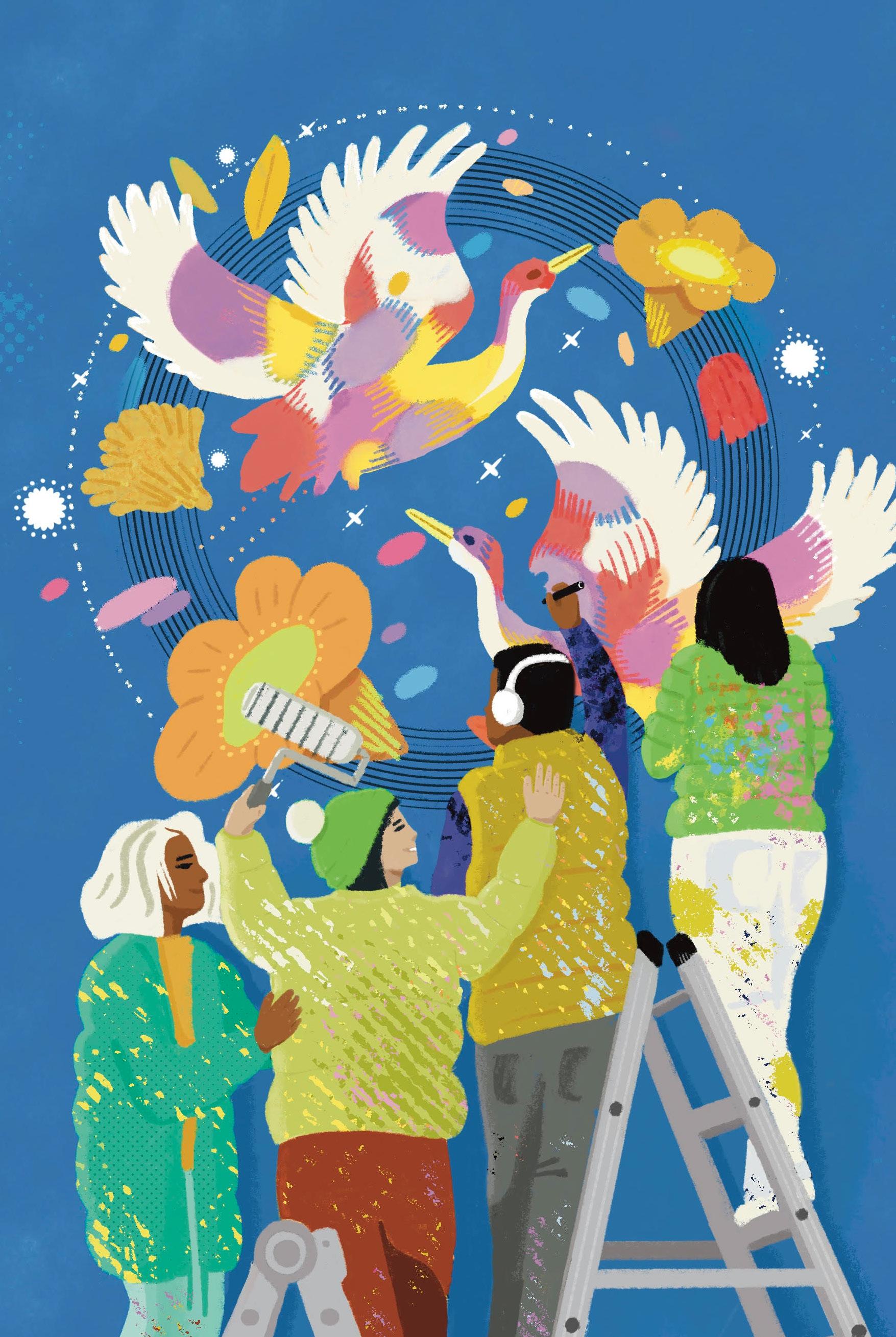




Every issue of Happiful is reviewed by an accredited counsellor, to ensure we deliver the highest quality content while handling topics sensitively.
Communicating effectively requires careful attention. Sometimes we think we may have got it right, to later realise we didn’t! There are many ways communication can be improved, head to p71 for tips. Ultimately, we want to ensure our message is being received as we would like it to be. Equally, we must be prepared to listen and absorb information from others. Communication is a two-way process, and the better we do it, the greater the connection.

NT DipCNM mANP
Claudine is a naturopathic nutritionist and health coach.

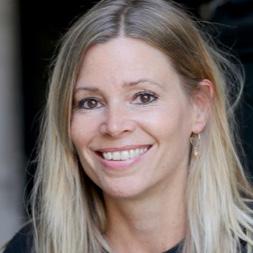
PGDip MBACP
Belinda is an integrative counsellor and psychotherapist.
Rebecca Thair | Editor
Kathryn Wheeler | Features Editor
Lauren Bromley-Bird | Editorial Assistant
Bonnie Evie Gifford, Kat Nicholls | Senior Writers
Becky Wright | Content & Marketing Officer
Grace Victory, Claudine Thornhill | Columnists
Lucy Donoughue | Head of Multimedia

Ellen Lees | Head of Content


Natalie Holmes | Sub-Editor
Rav Sekhon | Expert Advisor
ART & DESIGN
Amy-Jean Burns | Head of Product
Charlotte Reynell | Creative Lead
KATERINA GEORGIOU
BA MA PGDip Reg MBACP

Katerina Georgiou is an individual and group Gestalt psychotherapist.



MNCS (Accred)
Laura is a psychotherapist, and runs LD Therapy, in Oxfordshire.
FRANCESCA AMOR DipHe Acc NCS
Francesca is an integrative individual and couples counsellor.
Rosan Magar | Illustrator
COMMUNICATIONS
Alice Greedus | PR Manager
CONTRIBUTORS
Katerina Georgiou, Caroline Butterwick, Ronia Fraser, Kate Orson, Ella Delancey Jones, Linda Albinsson, Gabrielle G, Gemma Calvert
SPECIAL THANKS
Belinda Sidhu, Francesca Amor, Laura Duester, Louise Brown, Carrie McColl, Melanie Kirk, Filomena Komodromou
LOUISE BROWN
MSc MBACP ACTO
Louise is a therapist working with neurodivergent and LGBTQIA+ clients.


Aimi Maunders | Director & Co-Founder Emma Hursey | Director & Co-Founder
Paul Maunders | Director & Co-Founder
For new orders and back orders, visit shop.happiful.com, or call Newsstand on +44 (0)1227 277 248 or email subenquiries@newsstand.co.uk
BSc Dip CNM mBANT
Linda is head nutritionist at London’s Advanced Nutrition Clinic.
CARRIE MCCOLL
Dip Couns MBACP
Carrie is a counsellor working with young people and adults.
CONTACT
Happiful, c/o Memiah, Building 3, Riverside Way, Camberley, Surrey, GU15 3YL Email us at hello@happiful.com
HAPPIFUL FAMILY
Helping you find the help you need. Counselling Directory, Life Coach Directory, Hypnotherapy Directory, Nutritionist Resource, Therapy Directory
MELANIE KIRK
BA (Hons) Dip IAPT MBACP
Melanie is a relationship therapist currently undertaking an MSc.
FILOMENA KOMODROMOU
BA Hons Dip CNM mBANT
Filomena is a nutritional therapist working to empower clients.
If you are in crisis and are concerned for your own safety, call 999 or go to A&E
Call Samaritans on 116 123 or email them at jo@samaritans.org

SANEline
SANEline offers support and information from 4pm–10pm: 0300 304 7000
Mind
Mind offers advice Mon–Fri 9am–6pm, except bank holidays: 0300 123 3393. Or email: info@mind.org.uk
Switchboard is a line for LGBT+ support. Open from 10am–10pm: 0300 330 0630. You can email: chris@switchboard.lgbt
If you, or someone you know, is experiencing domestic abuse, find support at nationaldahelpline.org.uk or call 0808 2000 247 p34
To find support for grief and bereavement, head to cruse.org.uk or call their helpline on 0808 808 1677 p43


p65
If you want to learn more about nutrition, connect with a professional using nutritionist-resource.org.uk
Our two-for-one tree commitment is made of two parts. Firstly, we source all our paper from FSC® certified sources. The FSC® label guarantees that the trees harvested are replaced, or allowed to regenerate naturally. Secondly, we will ensure an additional tree is planted for each one used, by making a suitable donation to a forestry charity. Happiful is a brand of Memiah Limited. The opinions, views and values expressed in Happiful are those of the authors of that content and do not necessarily represent our opinions, views or values. Nothing in the magazine constitutes advice on which you should rely. It is provided for general information purposes only. We work hard to achieve the highest possible editorial standards, however if you would like to pass on your feedback or have a complaint about Happiful, please email us at feedback@happiful.com. We do not accept liability for products and/or services offered by third parties. Memiah Limited is a private company limited by shares and registered in England and Wales with company number 05489185 and VAT number GB 920805837. Our registered office address is Building 3, Riverside Way, Camberley, Surrey, GU15 3YL.
One undeniable truth is that finding the right help for each individual is a journey – what works for one of us will be different for someone else. But don't feel disheartened if you haven't found your path yet. Our Happiful family can help you on your way. Bringing together various arms of support, each of our sister sites focuses on a different method of nourishing your wellbeing – from counselling, to hypnotherapy, nutrition, coaching, and holistic therapy. Download our free Happiful app for more.
It all started when Chamiah Dewey was a team leader on the National Citizen Service programme, in the summer of 2018. One of the young people in her group had achondroplasia, the most common form of dwarfism. Chamiah saw the challenges the young person had navigating a world not built for people like them, so when she went on to study at the London College of Fashion, she began to research what kind of clothes were available for those under 4’10”, and found a dire selection.

“From the hundreds of people I have spoken to of short stature, and other disabilities, it is a common theme that they struggle with their self-esteem, because the clothing they have to wear isn’t accessible or designed for their body,” Chamiah told Happiful. “Not only do they have to deal with the fact that clothing isn’t adaptive, and often they have to have help getting dressed, clothing is also uncomfortable to wear and unflattering. They also don’t feel seen and heard by the fashion industry. We’ve gained some
inclusivity, yet we’ve still forgotten about the 2.3% of people who are short stature.”
And so Chamiah Dewey Fashion was born – a brand that creates timeless, elegant clothing for those under 4’10”. And the range is already making waves.
“As we become more well-known, feedback stays just as positive,” Chamiah said. “We’re really excited to make a difference, because there are 200 million people worldwide waiting for clothing designed for their bodies.”
Writing | Kathryn WheelerThe teenage years can be a challenging time – for teens and their parents. Knowing when, and in how much detail, to talk about topics such as puberty and menstruation can leave many parents feeling out of their depth and, for some dads, make them feel the need to turn to others for help. However, according to new data from intimate wellbeing brand Intimina, despite their discomfort, dads are stepping
up and taking responsibility for helping their daughters.
It reported that 76% of UK dads feel it’s their responsibility to know about the menstrual cycle to help their children, and 78% have spoken with their daughter about menstruation at least once, while one in five speaks about it frequently. Plus, more than three-quarters (76%) have bought period products for their teens.
The NSPCC is one of the UK’s leading charities for children, and this year they are back to spread festive joy with their annual Letter From Santa campaign. Come December, families across the globe will be preparing for Christmas, and receiving a letter from Santa is just one of the festive traditions that’s keeping the magic alive for children everywhere.
With a suggested donation of £8, parents and carers can order a personalised letter from Santa, which comes in eight enchanting designs, including a special World Cup theme for football fans. The letters can be personalised to make them unique to your child’s

achievements and experiences, and are “hoof-delivered” straight to your door.
One parent who has been ordering the personalised letters since her son was born, almost 10 years ago, says: “I hope that in years to come, they [the letters] will spark beautiful memories of friends, past interests, and achievements.”
Sadly, Christmas is not always a special time for children in need, which is why this festive fundraiser will help to drive donations amid the winter season, as well as spread the festive cheer. The money made will help the charity support children who need it the most,
Broaching the subject of menstruation can feel uncomfortable, but it doesn’t have to be. By opening up and showing it’s a conversation teens can have with any parental figure or carer, it can help teens feel more comfortable asking questions and learning about their bodies. It’s time to bridge the gap and take responsibility for supporting our daughters, no matter what the topic. Writing | Bonnie Evie Gifford and allow Childline professionals to answer more calls over the Christmas period, including on Christmas Day. So what are you waiting for? Order your letter from Santa today at letterfromsanta.nspcc.org.uk
Writing | Lauren Bromley-Bird


Smile lines and crow’s feet can tell a story of a life well-lived, yet some beauty brands remain determined to ‘reduce’, ‘refine’, and ‘renew’ them. A recent study by data analysts at Lifestyle Packaging looked at 41 beauty brands, to see how often anti-ageing language was used to sell products, and found the phrase “antiageing” appeared nearly 3,000 times across 730 pages.
There were also mentions of ‘youth’, ‘young’, and ‘youthful’ a staggering 2,700 times. Language like this matters, and according to gerontologists, it plays a significant role in how we feel about ourselves.
“Anti-age messaging is so embedded in our everyday life that most of us don’t even recognise it. And when it comes to beauty products, it’s pervasive,” says Rich Quelch, global head of marketing at Lifestyle Packaging. “However, it’s encouraging to see some brands blazing the trail with minimal use of anti-age language, while promoting their products to a mature audience.”
Campaigns such as Age Without Apology are paving the way, and some brands are stepping up – those with the lowest use of anti-ageing language include Soap & Glory, Liz Earle, Elemis, and The Ordinary.
Ageing is a privilege, and it’s time for us to embrace it.
Writing | Kat NichollsFrom 2025, all new buildings and homes in Tokyo will be required to have solar panels
Did you know that scientists have developed a bracelet than converts stress into energy when it’s stretched or twisted?
Have you ever met someone and it just... clicked? There are people who seem to have been destined to be in your life, but scientists now say that the ‘ultimate formula’ for creating a friendship that lasts is spending 34 hours of quality time together. Why not schedule in some social time with a budding friend soon?
Retired police dog, Logan, who survived being shot three times, is being honoured with a lifetime achievement award
When retired Scottish nurse, Joy Milne, smelt a distinct change in her husband’s odour, 12 years before he was diagnosed with Parkinson’s, she never would have guessed that scientists could use her uncanny skill to develop a swab to detect the disease – with an astonishing 95% accuracy so far.
Cracks and potholes in the pavement might not be that exciting normally –but French guerilla artist Ememem sees inspiration. He’s been filling these street blemishes with vibrant, geometricpatterned mosaics. Discussing the eye-catching work, Ememem poetically said that his works “illuminate the wounds of the urban fabric”. Now that’s the definition of a walk of art.
A new digital innovation sees your smartphone become an electronic stethoscope. The Echoes app simply requires a user to place their phone against their chest in specific areas to record the heartbeat, allowing doctors to tunein remotely to the rhythm, potentially detecting murmurs from a distance. Additionally, people can record the heartbeat of a loved one, for comfort and to feel close.
The most popular baby names in 2021 have been revealed, with Noah top for boys, and Olivia number one for girls
Festive favourite Quality Street has made a move to become more ecofriendly, by swapping its famous, vibrant plastic wrappers for a recyclable wax paper, to help to reduce the 2 billion sweet wrappers going to landfill each year.
Don’t hesitate to start ticking off those big dreams, as a study in the Journal of Personality and Social Psychology suggests we’re less likely to explore new experiences as we age – preferring to return to old favourites as time passes. Something comforting and familiar, whether it’s a holiday destination from our youth, or a restaurant with special significance, can be a way of creating more meaningful experiences in our later years. But don’t let scientists stop you from enjoying the old, and the new!
If you’re concerned about a child with fussy food habits, you’re not alone. A survey reviewing patterns of picky eaters found that kids are most likely to complain about Brussels sprouts, cabbage, and onions –vegetables definitely seem to be a common theme. But, perhaps more surprisingly, chocolate appears in the top 30 most avoided items as well. It’s certainly food for thought...
They may say dogs look like their owners, but apparently their personalities might match, too! A new study from The Kennel Club has found links between dominant personality traits in pets and owners, for example cocker spaniels suggest you’re creative and familyorientated, a dachshund signifies you’re trustworthy, and a golden retriever means you’re emotionally stable and happier, typically.
If ‘barely getting by’ is where you’re at right now, you could be dwelling in ‘survival mode’
Writing | Kathryn Wheeler Illustrating | Rosan MagarHere’s something that all of us can likely agree on: it can be really tough out there. The shared pressure to do and be more, the waves of bad news that flood our lives, and the personal challenges that we’re forced to face – it’s a wonder we’re able to manage at all. Except, actually, sometimes we aren’t. Sometimes, stress tips us over the edge, and our bodies respond.
“In simple terms, ‘survival mode’ is our body’s automatic response to danger,” counsellor and psychotherapist Belinda Sidhu says. “It’s what has helped us to survive, to get to this point. This response begins in one of the oldest parts of the brain, the limbic system.

“When someone confronts danger, the eyes, ears, or both send information to the amygdala – a part of the brain
which can act a bit like an alarm system.
The amygdala interprets those images and sounds. When it perceives danger, it instantly sends a distress signal to the hypothalamus – which functions a bit like a control centre communicating with the rest of the body through our nervous system – and controls hormone release. This can lead to that fight/flight/freeze response.
“This response can absolutely be helpful and aid in our survival if, for example, we’re crossing the road and a car turns a corner unexpectedly. Yet, it’s not so helpful if we’re experiencing it when a stressful email pops up. However, the unfortunate element of the amygdala is that it cannot differentiate between the two ‘dangers’, and which may be an actual threat to our survival.”
As Belinda explains, stress is a very normal part of life – and it can even help motivate us, in small doses – but, over time, it can reach a tipping point where it begins to detrimentally affect your life, making it almost impossible for you to concentrate on anything else. At this point, you could enter ‘survival mode’.
“When we go into ‘survival mode’ – or experience the fight/ flight/freeze responses – we may notice a number of physical, emotional, and behavioural signs,” Belinda explains. As she sees it, these include…
Physical signs: Aches and pains, trouble sleeping, muscle tension, or jaw clenching. You may find yourself grinding your teeth in your sleep and waking up with a sore jaw. Stomach or digestive problems, bloating, high blood pressure, or headaches.
Emotional signs: Being more emotional than usual – maybe more irritable, getting angry or frustrated at things that wouldn’t usually cause you anger, feeling overwhelmed, or on edge.
Behavioural signs: You may have trouble keeping track of things, making decisions, solving problems, concentrating or getting your work done. You might find yourself procrastinating and avoiding your responsibilities. You may be ‘self-prescribing’ – drinking more alcohol than usual, or using substances such as recreational or prescription drugs.
As Belinda points out, the longterm effects of stress can be really serious. Stress can lead to other mental health problems, such as
anxiety and depression, as well as affect our physical health, as explored above. But, what’s more, studies have even shown that chronic stress can have a shrinking effect on the part of our brain called the prefrontal cortex, the area responsible for memory and learning. It can also affect the size of the amygdala, making our brain even more receptive to stress – catching us in a vicious cycle.
part of your life is causing the stress, come up following her questions? Perhaps you’re overstretched at work, or your home life is getting on top of you. It can be really hard to put that boundary in place, though, and Belinda recommends being clear with the language you use (turn to p71 for tips on that), and holding your ground if a boundary is crossed.
So, how do we break out of it? “Take account of your current situation,” Belinda says. “Try asking yourself, ‘What’s flowing into my stress bucket?’ Spend a few minutes thinking and noting down what’s currently going on, and then think about healthy coping mechanisms you could use to help open the tap to let some of that stress flow out.”
Belinda also suggests that this is the time to set some boundaries. Have any clues, about which
“There is a growing body of research suggesting mindfulness can help reduce stress and anxiety,” Belinda adds. “There is so much out there on mindfulness, from YouTube videos to mindful apps such as Calm and Headspace.” Finally, Belinda suggests taking a holistic view of your wellbeing: are you moving your body? Are you eating well? Both things that can have a huge impact on our overall wellbeing.
All that said, sometimes we all need a helping hand. So, if you’re stuck in ‘survival mode’, and you can’t see a way out, reach out to your GP or a mental health professional. Because we all deserve the chance to live to our full potential.
‘Survival
If someone is drowning, it’s well understood that people don’t necessarily thrash –survival instinct kicks in, and they can look calm to an untrained eye. Yet, when we’re metaphorically drowning in life, we forget to apply that principle.
If we could learn to spot subtle signs of drowning in stress, we could really change our relationship with it, and how we can be there to help each other.
I actually have a story which really epitomises this secret stress bubbling away. I was halfway through a six-week hike, when a friendly man approached me with some almonds. Despite his kind intent, I shut down. I was weary, my body was tired, and I was on the verge of quitting. Feeling out of sorts, in unfamiliar surroundings, I became hyper-vigilant.
I remember watching him take my hand and turn it around. I froze as he put nuts into it. My heart pounded. I threw the almonds to the ground and cried. Feeling incapacitated, already
stressed, in open land with little way to get help if I needed to, my body only registered a threat. While we’re familiar with the terms fight and flight – the response when faced with danger, preparing you for action – there are actually five ‘fs’: fight, flight, freeze, flop, and fawn. What happened to me, in this instance, was a mix of freeze and flop.
So, how can you identify and address each ‘F’?
In fight mode, you’re tackling things head-on. Full of adrenaline, your thoughts take a back seat as your heart rate increases, pumping blood throughout your body. You might take more risks, like running into a road to save a child. This can feel primal. Be aware of what’s happening in your body, and remember to take a breath. It will be important for you to take time out after a period of stress to let your body settle and recover.
Problems don’t feel like challenges to be tackled, but obstacles to be avoided. You feel vulnerable, tight in your chest and gut, and instinctively want to avoid, run away, or retreat. You might be very aware of the exit signs in an enclosed space, and may even figure out your escape routes in advance. If your pattern is to flee, place your feet on the ground and breathe deeply and slowly. Stick with your discomfort, and allow it to pass. This will give you time to explore your options. What do you need to make this situation less stressful?
You’re like a rabbit in headlights, and your feet feel stuck to the ground. This can happen when escape isn’t possible, because running may lead to a chase, or fighting back invites more attacks. In this state, it is difficult to make any decisions, and sometimes you can’t ask for help because you don’t know what to
Stress presents itself in many forms. Learn how to spot and address it from every angle
ask for. It can also feel like all your senses are blocked, and all your energy is locked inside your body with no way out. If this happens to you, let the blankness in for a while; let it be and don’t try to change it. Paradoxically, this will make it pass. This can be helpful if you’re performing on stage, and your mind goes blank.
You might faint, feel dizzy, or dissociate – disconnecting from your thoughts, feelings, or sense of self to cope with the stress. This can be short-lived or last a long time. If you know you’re liable to black out or faint, try letting people know in advance so they’re aware to look out for


you. If you spot someone in a predicament and they appear in a state of flop, let them know you’re there, they’re safe, and place your hand out so that they can take it if they wish to, giving them agency.
This happens when you move closer to the threat causing you stress, because this is what’s keeping you safe. Sometimes, this can serve you well; other times, you can enter into scenarios you’d rather not be in. For example, making you bite off more than you can chew at work, or you befriend somebody you intuitively feel uncomfortable around out of fear of displeasing them. It can be helpful to ask yourself this question in advance: what penalty do you picture for saying no? What can you deduce from this?
We aren’t always in control of how our stress and responses to threats show up, but understanding that it’s your body’s innate way of keeping you safe will help you cope with it better.

Being able to better express exactly how you’re feeling can allow those around you to help – so consider, when you say you’re ‘tired’, what do you really mean?
Your energy reserves are depleted, and this feels like an emotional response. You might lack motivation or feel hopeless, and want to remove yourself from social situations.
This is a mental tiredness, where you may have reached breaking point. You might struggle to concentrate and make decisions, and feel irritable and emotional.
Your battery is near empty. This can be a physical sense of being tired, where you’ve been rushed off your feet for too long, and it’s wiped you out.
A mixture of being worn out and mentally drained, but with lots still on your plate, you might feel on edge, and unable to switch off. This can be like a nervous energy, but you’re running on fumes.

Sometimes thought of as a type of ‘soul’ exhaustion, not being stimulated or engaged enough can lead to feeling detached, or like you’re lacking in meaning or purpose to do anything.

In a more literal sense, this can be when you need rest and to go to bed. Perhaps you’ve not slept well, or had a long day that’s taken it out of you – it could even be a result of excitement and activity, so not always a bad type of tired.

For yourself, and for your loved ones, make sure you’re in the know when it comes to mental health rights
Writing | Kathryn WheelerGetting help for mental health problems can be daunting, but knowing what rights we are all entitled to lays a good foundation from which to take those first steps forwards.
There is some variation to the specifics in different countries in the UK, so it’s always a good idea to seek advice for your particular case – but, here, we’ve created a quick, simple guide to mental health rights, so you can become an advocate for yourself and for the people around you.
All employers have a duty of care for their staff, which means that they must do all that is reasonably possible to support staff’s health, safety, and wellbeing. Legally, there’s no difference between a sick day taken for mental or physical health, and you can take ‘mental health days’ when you need them – you’ll just have to follow your company’s usual process for taking the day off sick.
Beyond that, a mental health problem may be considered a
disability under the Equality Act 2010 if it has a ‘substantial adverse effect’ on the individual’s life, is expected to last at least 12 months, or affects their ability to do day-to-day activities. If this is the case, the employer must not discriminate against the employee because of their disability, and they must also make ‘reasonable adjustments’. These adjustments might include flexible hours to allow for appointments with GPs and mental health professionals, support with >>>

working practices and workload, and training.
For more information, visit acas. org.uk. Additionally, joining a union means you have someone in your corner, who can advise you on your specific case as and when needed – to find a union for you, visit tuc.org.uk/joinunion
Children and young people under the age of 18 have many of the same rights as adults, although there are some differences to be aware of.
While a young person is in education, if they have a disability or school is difficult because of their mental health, they have the right to access extra support, which might include things like: a safe, quiet place to go at lunch or in between lessons; extra help from a member of staff; and extra time on exams.
Under-18s also have the right to be involved in decisions made about them, such as the kind of treatment and support they will get, who should be involved, and the kind of support that they will get from schools.
Lawstuff.org.uk offers free legal information to children and young people in England, and childline.org.uk can also provide general information about rights.
When you go to see your GP about your mental health, you have all the same rights to patient
confidentiality that you would do during an appointment about your physical health.
With some exceptions (such as, for example, when you need emergency treatment, have been detained under the Mental Health Act 1983, or are a serving member of the armed forces), you have the legal right to choose which mental health provider you go to in England.
The NHS must also respect your human rights, and you can find out more about mental health and human rights by visiting bihr.org.uk and search for mental health.
At present, there is no legally enforced regulation of counsellors and psychotherapists in the UK. So when it comes to working with a counsellor, it’s really important to find someone who has been accredited by the Professional Standard Authority (PSA), which means that they have met the PSA’s professional standard requirements.
Client confidentiality applies to your sessions. However,
although there is no obligation for a counsellor to answer police questions about a client, guidelines from the Department of Health state that breaching confidentiality in the case of serious crime is appropriate, and the Terrorism Act 2000 makes it a criminal offence for a person not to disclose information that might prevent someone from carrying out an act of terror.
You also have the right to file a complaint about a counsellor – if you have been mistreated, or if they have failed to meet the standards set out by professional bodies – and you can do so by visiting the board’s website.
When it comes to your, or a loved one’s, mental health, you deserve to be heard, supported, and have confidence that you’re getting the help you need.
Know that it’s OK to speak up for yourself and others – every voice united in advocacy will ring through louder and louder.
You can read more about mental health rights, and find an accessible guide to the Mental Health Act at nhs.uk
Legally, there’s no difference between a sick day taken for mental or physical health
As our wonderful columnist Grace Victory embarks on an exciting new chapter in her life, and pens her final column for us, she reflects on the passage of time, as well as the lessons from endings – and new beginnings
If I’ve learnt one thing in the past few years, it’s that nothing lasts forever. Whether it’s a particular feeling, trauma, a job or a friendship, sometimes things run their course, seasons change, and what we once wanted or needed, we no longer desire.
Emotions like happiness are fleeting, often depending on outside sources, and feelings like sadness can be due to weather, or hormones, or scrolling aimlessly on Twitter (we all do it LOL).
Our feelings can change so dramatically through the day that we can’t place too much attachment to them. They can transform. They end. They don’t usually last too long. And I think that’s actually a pretty beautiful thing about humanity. Difficult relationships can eventually reveal a way out and forward, we might be made redundant from a job we absolutely loathe, and childhood trauma could end when we grow into adulthood, put the work in, and heal.
| Grace Victory
Endings are the place where beginnings can start, and while refreshing and beautiful, they can often feel messy and uncomfortable – especially if, like me, you have a need to feel in control.
Life is unpredictable, and we must ebb and flow like water to become resilient to what is brought our way. This includes doors being shut in our faces, or us having the courage to slam them shut ourselves. The end of something can be a mourning period, but also a time to reflect on what’s been, how we feel, and how we’d like to move forward.
As the year draws to a close, I always feel pensive and more aware of my thoughts, especially now that I’m a mother and have overcome critical illness. You don’t come back from death (both in the physical and spiritual sense) and just pick up where you left off. Everything feels different. Everything is
different. And time to re-evaluate is important.
As my maternity leave is in full swing (and by the time you read this my second-born will be here), I’m in the space of starting a new chapter. A chapter where I’m a mother of two, where I’m rediscovering parts of myself that I’ve lost, but also finding parts of myself I never knew were there, and just hitting pause so I can think, focus, and decide on what the future looks like for me. Contracts and collaborations with incredible brands are ending, and I am (for the first time) taking a long break away from work and social media. The only break I’ve had in 12 years was when I was in a coma, which doesn’t bloody count!!
I’m tired.
Tired to my core, and very much in need of taking some time out to be with my family, continue healing, and find other things – new, exciting things –that bring me contentment and
joy. While happiness is so fleeting, I believe peace can be a constant, and that is something I’d like to work towards. Long gone are the days of being OK and comfortable with chaos; I need stillness and to do that, I need to cut out some of the noise, my ever growing list of tasks and, of course, the to-do list that I’ll probably die with!
With that being said, I have also made the decision to end my Happiful column. For no other reason than just feeling like I need to move on, and give this energy to myself and my family. I have utterly loved this corner of content to share my thoughts, give advice, and connect to my readers. Over the years, it really has become my safe space, and the only place I delve into certain topics.


To the team, especially Lucy, thank you for having my back and allowing me to use my column so freely. Happiful really is a breath of fresh air.
To you, the reader, for taking the time to read my words, thank you.
Moving on is never easy for me. I ponder, overthink, and sometimes second guess my decisions, but I know that all of these endings are catalysts for change and growth, so I’m embracing them with open arms.
“But what if I fail? Oh, but my darling… what if you fly?”

In a brisk corner of the internet, more than 4,500 people come together for worldwide tropical cyclone discussion, and general weather observations. This group is made up of followers of Nathan Foy – creator of Force Thirteen, a YouTube channel that produces videos on cyclones and weather forecasts. But who could have predicted the force for good this community could become?
“Our community mostly resides on Discord [a chat app for voice, video, and text], and is open to anyone,” says Nathan, when asked to reflect on the space he has created. “We still very much are mainly weather-related, but we opened a ‘room’ for care and support a couple of years ago, under the initiative of our moderator team.”
When Nathan saw an increase in the amount of personal issues coming up in general conversations in the group, the
team decided to take action to make their community a supportive space. Drawn together by their shared interest in cyclones, the group now also offers the option of informal peer-to-peer support, a fleet of moderators ensuring it all remains safe.
Talk of Discord servers and digital moderators may feel uniquely 2022, but the desire to gather is, of course, not. In fact, it’s going right back to basics. Coming together, meeting people where they are, building communities, and weathering the storm together – these are the practices that built our society in the first place, and that gave our modern world its foundations. And the more pressure we put on those foundations – the higher we build and the further away we get from our roots – the more we need to return to them, to nurture them, and to come together once again.
The group of Nordic countries (Finland, Denmark, Norway, Sweden, and Iceland) that consistently dominate the top spots in the World Happiness Report (WHR) have a couple of things in common. It’s important to acknowledge the financial climate – high GDP per capita, a welfare state, and ample social benefits – but beyond that, the WHR looks at other factors, including social support and generosity.
They’re the kind of values we might associate with ‘village living’. The phrase alone might conjure up images of a stroll to the local shop, the walk punctuated by friendly encounters with people you know by name, and who would be round in a jiffy the moment you need a hand. The good news is that this ‘village’ style connectivity isn’t particularly geographically restricted. >>>
What role do togetherness and kindness play in our communities, local and beyond?

In figures from the Department for Environment, Food and Rural Affairs, when asked “Overall, how happy did you feel yesterday?”
on a scale from 0 to 10, where 0 is “not at all happy” and 10 is “completely happy”, those living in predominantly rural areas gave an average rating of 7.47, only marginally higher than the average
rating of 7.25 given by those living in predominantly urban areas. What’s more, in a report into community life, which ran from April 2020 to March 2021 and was published by the Department for Digital, Culture, Media & Sport, 65% of respondents agreed that people in their neighbourhood pull together to improve their
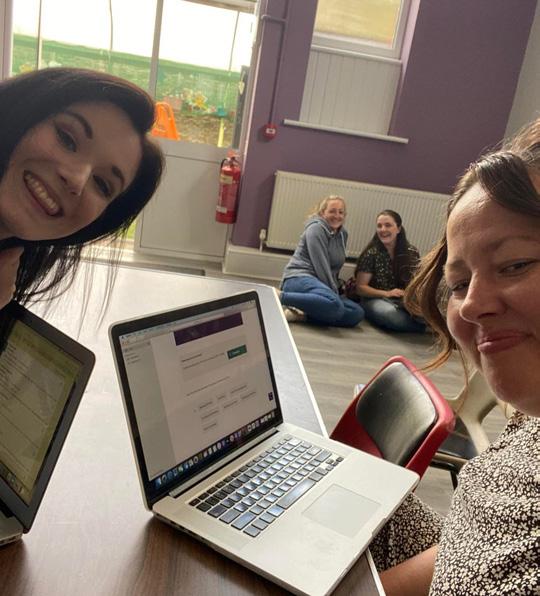
neighbourhood – an increase from 59% in 2019/20 – a sign things could be on the up. And, yet, alongside all this, the Campaign to End Loneliness reports that 45% of adults feel occasionally, sometimes, or often lonely –equating to 25 million people feeling isolated to some extent. So what’s going wrong?
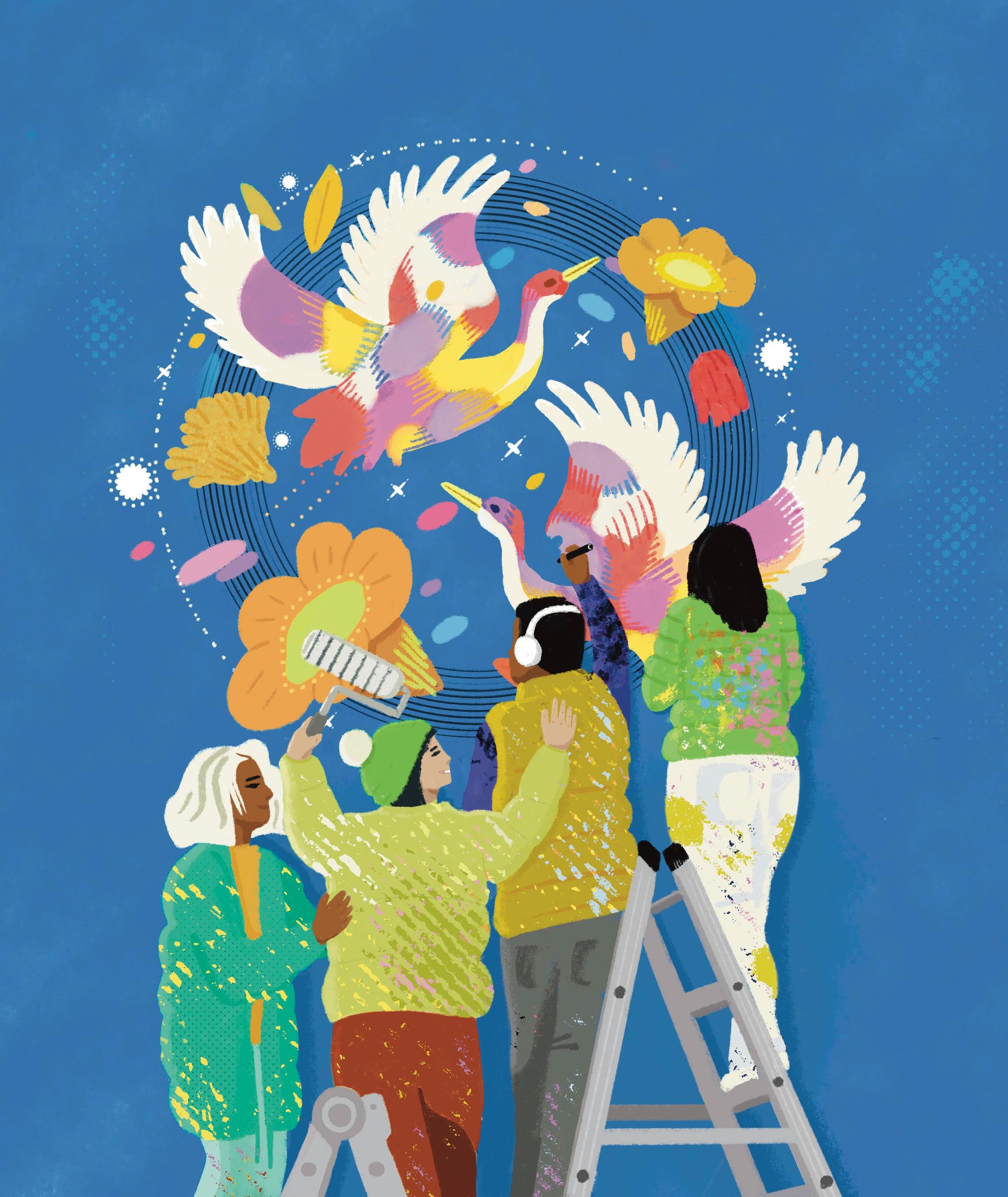
There’s likely been a point in all our lives when we have felt some kind of isolation, and the truth of the matter is, we can’t really pin it on one thing. Feeling financially excluded from social events, poor work-life balance, health, and limitless other factors can leave us feeling excluded. But the benefits of community are incredibly fruitful – it makes us feel safe and secure – and a study of the unusually longliving population of Sardinia, Italy found that strong ties to family and friends, along with physical activity, contributed to their long lives. Back in the UK, there are beams of hope, such as Nathan’s unlikely wellbeing hub, and Ceri Gillett’s inspired solution for working mums.
“When I became a mum in 2015, I really struggled to find a space for myself,” Ceri tells us. “I was starting a new business, and heading to baby groups just wasn’t my cup of tea. I’d find myself sitting on the sidelines, not engaging with others, and wondering why I came. I needed a space that would allow me to express both parts of me, as a mum, but also a woman starting a business, and I couldn’t really find it.”
So Ceri created a community platform, Mubo, that offers support for working parents, who feel directionless since becoming parents, can’t afford childcare or school holiday clubs, or can’t travel to other childcare provision. Today, there are seven Mubo Hubs across Wales.
In these local hubs, parents share childcare and work –with parents doing alternate shifts, working half the day, and watching the children the other half, and vice versa. They hire in kids’ activities and split the cost amongst all the parents to keep it low and give the parents a chance to work, everything propelled forward because the load is shared.
When the challenge feels too big to tackle, start small:
• Offer to do a ‘skill swap’
• Organise a community clean-up
• Identify areas that need improvement, and see what can be done (e.g. underlit streets)
• Look up local volunteering opportunities
• Set up a Whatsapp or Facebook group for the people on your street
• Create a community garden
• Support local businesses
• Offer to go to the shops for those who can’t make it out
• Donate to local food banks
• Offer to do some gardening for those who can’t themselves
• Start a newsletter
And as we face difficult times ahead, communities are more needed than ever before. “I’ll definitely be thinking about new ways to get the community together, yes,” says Nathan, when considering this forecast. “For the past two years, our community has been involved in raising money for our annual Force For Good event in December, and we plan to do that again this year on the first Sunday of December. This is a fundraising initiative that involves live streaming to raise funds for those in need.”
The necessity of fundamental change, in order to achieve the kind of nation-wide happiness that is enjoyed by Nordic countries, cannot be underestimated – but pockets of
• Campaign for more community spaces
• Make a note of people’s birthdays, and pop cards through their doors
• Get to know service providers like bus drivers and postal workers
those systems can be found all over the UK, dreamed up by the determined, devoted people who believe in better. Big and small, those things that we can all do to nurture our connection with the people around us, they make a difference. The sort of kindness that Nathan and Ceri have used to create a sense of togetherness in their own ways, is available to us all – the only thing left to do is to take the first step.
65% agreed that people pull together to improve their neighbourhood
Individual and couples counsellor Francesca Amor answers your questions on feeling financially trapped

Get emotional support on the Counselling Directory
QI’m unhappy in my relationship, but we live together and I can’t afford to leave. How can I cope?
AThis could be a tricky situation; the first thing to do is not rush into quick decisions. Is there any chance of you rescuing
what is left of the relationship? Maybe couples counselling can help. It could help you rediscover a new relationship with the same partner, or avoid dragging on an unhappy relationship, and find a way to part amicably. Separation and divorce can be costly, so take your time and explore your options carefully.
If you cannot leave yet, try to divide spaces in the house. You could sleep in the guest room or rearrange beds. Be sure to discuss boundaries, who is in charge of what, what the expectations are, and how to live comfortably in the same house. And in the darkest moments, remember that it is not forever, but just temporary.
QI currently live with my parents. I’m saving to move out, but I’m craving space. How can I make staying here more manageable?
AIf you are lucky enough to stay with your parents to be able to save money for a
deposit, try to make the most of it. Of course, staying with parents as we become adults can be very challenging – they may still consider and treat us like children, no matter our age.
The secret to being treated like adults is to behave like one. Volunteer information, instead of having a barrage of questions from them. Contribute to things
like house chores, buy some of your food (especially if you have different tastes), and maybe even treat them sometimes. Stay in when they are out, and go out when they are in. Join a gym, a course, or a class in the evening. Do not lose your focus: you are there to save money to be able to move and have a better start in life. Be positive, it will happen.
Counselling Directory is part of the Happiful Family | Helping you find the help you need
I feel financially trapped, what can I do?
1. Be patient, do not rush into decisions.
2. Planning is the key, it could take time, but you will get where you want to be.
3. Get help if you can from experts, possibly more than one to have a wider choice.
Feeling trapped is a horrible feeling to experience, but it is a phase in your life, and it will get better. Try to break targets into smaller ones, making them easier to achieve. Try also to live one day at a time, as thinking too far ahead could generate anxiety.

A When you start to look for a job, scrolling through job ads, talking to recruiters and doing interviews, you are already moving forward. Even if you do not have an offer on the first or second application, or you haven’t found what you’re looking for yet, do not give up. It takes time to get the right job. You might even want to consider a change of career. It will take more time, some training, but if you believe in it, it will happen. It is a process of patience and planning, taking one step at a time.
In the meantime, find other things to do outside of work, find new hobbies and interests – something rewarding that you are passionate about. Think about your current job as a transaction: skills and time in exchange for money. It allows you to pay for your bills, food, holidays, and job hunting.
QWork feels really tough right now, but I need the salary and am struggling to find an alternative. How can I keep going while I job hunt?Francesca’s top three reminders for those feeling trapped
For those of us who celebrate, the holidays are bound with traditions and ideas of what a ‘perfect Christmas’ looks like. It can be a time of year full of additional pressures we don’t need, from feeling like we have to cook an Insta-worthy roast, to buying presents that painfully dent our bank balance, or spending the day doing things we don’t enjoy but feel obliged to do.
But by thinking about what really matters to us at Christmas, we can help make it into something that’s meaningful and magical.
Contemplating what’s meaningful to us can benefit our mental health, and reduce the stress of the holidays. “People who have a sense of purpose in life feel more satisfied and content, have fewer health problems, and even live longer,” says counsellor Laura
Duester. “Finding a sense of meaning at Christmas is therefore great for both your mental and physical health, and will help support your wellbeing into the new year.”
With the cost of living rising, the pressure to spend lots at Christmas can be stressful. Counsellor Louise Brown suggests making space for your feelings about financial pressures, and responding to these feelings with kindness.
“It can be helpful to share your feelings with others, as it is likely that others will have similar experiences, and may be relieved that you have brought this up,” says Louise. “Offering mutual support and sharing ideas can help us to feel more comfortable with some of the harder decisions we have to make.”
It’s easy to fall into a comparison trap. Social media and adverts are filled with images of happy
family gatherings, and if this doesn’t echo our own experience, we can be left feeling lacking or hurt. But the images we see don’t always reflect reality – from burnt roast potatoes to missing loved ones. Whether it’s a friend bragging about buying their child the latest toys, or pressure from displays in shop windows, remember that this is just a snapshot.
“Try to accept Christmas as it is, rather than having ‘perfect’ expectations,” suggests Laura. “Just like any other day, it will have great bits, but lots of imperfections and challenges, too.”
Once you’ve let go of comparisons, try thinking about what you would love to do at Christmas, regardless of what you assume is expected of you. From creating and embracing new traditions to letting go of the things that aren’t important to us
Take the stress out of festivities by figuring out what means most to you, and discover your own new traditions along the way…
now, we can have a Christmas that’s personally meaningful to us and our loved ones.
Thinking about your values can help you work out what a meaningful Christmas would look like. “It’s important to be curious about what’s meaningful and important to you,” suggests Laura. “It might help to imagine how you’ll feel when January comes –what will you want to remember doing and enjoying over the festive period?”
Laura adds: “There are no right or wrong answers about what’s meaningful to you – we usually think of family time, eating, and presents as key to Christmas, but they don’t have to be. Perhaps relaxing, catching up on reading, getting out in nature, or spending quality time with your partner is more important for you. Whatever you think is valuable, make it a priority, and ensure you save enough time and energy for it.” >>>

Make sure you don’t get swept up in
to make everyone else happy at your expense
This may mean embracing new traditions. If you and your loved ones are bookworms, how about trying the Icelandic tradition of gifting each other books on Christmas Eve? Or perhaps you’d like to spend some of the day with friends, watching TV, or going for a walk. Or if you aren’t a fan of the traditional roast, why not switch from turkey to tacos?
Understanding your values can help you decide what to do. Are the holidays about quality time with family, or making space for self-care? If you’ve had a hectic year, could scheduling in rest be something that helps you?
If you’re celebrating with others, Louise suggests considering what is important and meaningful to each of you. She recommends asking both yourself and those you’ll be with these questions:
• “What are your three favourite things to do at Christmas?”
• “What was your favourite Christmas and why?”
• “What brings you the most joy at Christmas?”
• “If you could change one thing about Christmas, what would it be?”
• “What would you most like to skip at Christmas?”
• “If Christmas was easy, what would it look like?”
It’s important that everyone knows there are no right or wrong answers. Louise recommends looking for similarities in the responses. While you may not be able to honour everyone’s wishes, this can be a helpful starting point. You may learn that you all love watching The Muppet Christmas Carol, or having a laugh playing charades, but don’t currently make time for it.
Louise explains that doing things like planning activities that people can opt in and out of, without being made to feel guilty, can help everyone enjoy the day.


If there is something you don’t want to do, but another person wants to continue, there may be tension. But this is a chance for a change in responsibilities.
“The first year I said I didn’t want to cook a roast dinner anymore, other people stepped in to do it,” Louise says. “Or if everyone wants to eat different things, maybe you could buy a selection of ready prepared dishes, so everyone gets exactly what they want.”
While weighing up others’ wishes, don’t forget your own wants and needs, and get swept up in trying to make everyone else happy at your expense.
“While traditions can be important to some people, they can cause unnecessary distress to others who feel pressured into taking part,” says Louise. “Giving yourself permission to throw out the rules you may have created for yourself around the festive period can create a wonderful opportunity for something new and meaningful to emerge.”
Whether you’re tucking into a tub of Quality Street with friends, or curling up with a hot chocolate and a new book on Christmas Eve, take time to make this Christmas one that’s meaningful for you.
Giving yourself permission to throw out the rules around the festive period can create a wonderful opportunity for something new and meaningful to emergeLaura Duester is a psychotherapist who creates a safe, supportive, and empathetic space. Louise Brown is an integrative counsellor helping you explore your past and present, to inform your future. Find out more on the Counselling Directory.
From an emotional read about two soul mates to learning how to navigate the power of rest, we share four books you won’t want to miss

 Writing | Lauren Bromley-Bird
Writing | Lauren Bromley-Bird
As a society, we can often succumb to the pressure to be consistently productive, but how much better would we feel if we just allowed ourselves to rest and prioritised our wellbeing? With the onset of winter, many mammals begin to hibernate to conserve energy, and this is something we could all
12
I Love You by Olivia Poulet and Laurence Dobiesz Out now Pippa has been involved in a lifechanging car accident, and the next 12 hours are critical in her recovery. Her husband Steve sits at her bedside, reflecting on past memories, the ups and downs of their relationship, and the reasons why he loves her, in a bid to keep her fighting for her life. Is it too late, or will their love prevail?
Award-winning broadcaster, writer, and academic psychologist Claudia Hammond shows us how to do

While it’s cold and gloomy outside, this is the perfect opportunity to get creative with seasonal ingredients, and nourish yourself with hearty, warming meals. From delicious casseroles to winter salads, indulge in more than 75 recipes, and stay energised during the cold days ahead.
Art of
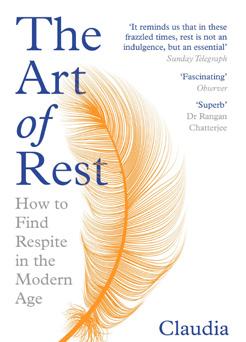
Modern Age by Claudia Hammond Out now benefit from doing. So why not use this season to retreat and repair ourselves, just like the animal kingdom?
exactly that by gifting us with a roadmap towards a more rested and well-balanced life, as well as examining the science behind rest and why it matters.
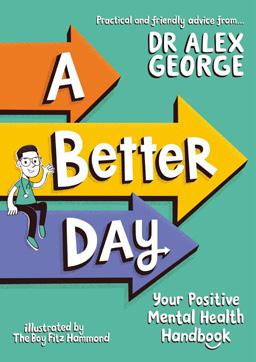
If you find it difficult to navigate conversations about mental health with your children, this friendly guidebook is the perfect resource. Written by Dr Alex George, this toolkit provides young readers with techniques on how to take care of their mental health, so that they can overcome struggles with empowerment and confidence.
It’s a long road to recovery following emotional abuse, manipulation, and gaslighting, but the following suggestions can help to ease that journey
 Writing | Ronia Fraser
Writing | Ronia Fraser
Over the past couple of years, narcissistic abuse has become a social media buzzword – more and more people are becoming aware of the signs, and working to break free from it. Since 2017, I’ve been helping abuse survivors from all over the world to get back on their feet, regain their mental health, and recover who they were always meant to be.
Every person who walks through my door says something along the lines of, “I don’t know who I am any more.” Or, “I don’t recognise the person looking back at me in the mirror.” Some don’t even see anyone else at all. The complete loss of self, caused by the tactical erosion of identity, is one of the most difficult and heartbreaking consequences of narcissistic abuse.
The good news is that with the right tools, and the right support, you can find your way back to you, and when you do, this connection with yourself will be stronger than you could have ever imagined. So, how do you do it?
It’s really easy to feel sorry for ourselves when we’ve experienced such unspeakable horrors and struggle with our mental health as a consequence. Is it fair? Absolutely not. The reality, however, is that we can’t change what has happened. All you can do is change how you feel about it. Can you take full responsibility for yourself and your recovery, make life happen, and feel empowered and in control? The decision is yours. Remember: you are the CEO of this operation!
your whole life sacrificing yourself, and have always put others’ wellbeing before your own. Now is the time to change that. It’s like you putting your oxygen mask on first on the plane before you help others.
Self-care is where the magic happens. It is essential to put a solid, daily self-care routine in place, whether you like it or not – and I promise you that you’ll learn to love it.
Remember: no contact is your number one self-care decision!
5. Take action
1.
This is the most important rule of abuse recovery. Also, admittedly, one of the most difficult steps to take. If you stay connected, even if it’s keeping their number on your phone, just in case, you will not heal. Period.
Does this mean you’re selfish? Does this mean you’re a bad person? Does this mean you’re turning into a narcissist yourself? No, no, and no. No contact and narcissistic silent treatment are not the same at all. It serves your self-protection.
If no contact isn’t possible due to shared custody or legal proceedings, the contact needs to be highly modified and kept to the absolute minimum, with no personal touches at all, ideally through a neutral third party and/or apps such as OurFamilyWizard (ourfamilywizard.co.uk).
3. Shift the focus
Shift the focus away from them, and what happened, and onto yourself and your healing. There is a time for reading books about narcissists and victim stories, and engaging in self-help groups, but eventually, you need to start to focus on yourself and begin to learn about things that actually will move you forward.
I cannot stress enough the importance of self-care in finding yourself. This is something that very likely doesn’t come naturally to you. You’ve probably spent
Many are looking for a magic pill that’ll make all of this go away in a blink of an eye. Sadly, that doesn’t exist. There are no shortcuts. What we are dealing with here is multi-layered, deep, and complex trauma. The only one who can fix this is you. You will have to put in the work and go all in, whatever it takes –though you are not alone in this, and it’s OK (and necessary) to ask for professional help.
The good news is that with the right tools, and the right support, this is actually much easier than you think, and doesn’t have to be a long and painful process. So, make yourself your top priority today. Be 100% determined and committed to your healing. Persevere and you will succeed.
Ronia Fraser is an award-winning trauma recovery coach, clinical hypnotherapist, and trainer. She is also a survivor of narcissistic abuse. For more information, visit roniafraser.com
With the right tools, and the right support, you can find your way back to you
When the world is dragging you down, remember there’s plenty of positives out there, too. Enjoy our rundown of 44 sensational stories from 2022, to give you a more optimistic outlook
Writing | Rebecca ThairParts of the Great Barrier Reef are reportedly showing the best signs of coral recovery in 36 years!
As of September 2022, Denmark has become the first country in the world to offer ‘loss and damage’ compensation to developing countries affected by climate change, in the form of €13.4 million.
In a major milestone, there are now enough solar panels around the world to generate 1 terawatt of electricity.
Based on current progress, scientists estimate that the hole in the Earth’s ozone layer will close around 2070!
In a truly selfless and generous act, an anonymous French man who won the Euromillions jackpot has used his €200 million winnings to start an environmental charity.
In August, the world’s largest offshore wind farm, based off the Yorkshire coast, was declared fully operational. It features 165 wind turbines, and will help to provide renewable energy to more than 1.4 million UK homes.
WasteSharks are the latest incredible innovation tackling plastic waste, utilising drone technology. Designed by Dutch company RanMarine, the aquatic drones were inspired by whale sharks catching their prey, with each one able to hold up to 160 litres of waste.
Hawaii closed its last coal power plant to focus on greener energy options, removing the 1.5 million metric tons of greenhouse gases it created each year.
In a world-first, the National Grid is removing 22 electricity pylons from Dorset’s Area of Outstanding Natural Beauty, and is replacing them with 60 miles of underground cables, in a bid to return the landscape to its natural form.
In April 2022, the Animal Welfare (Sentience) Bill was passed into British law, in a landmark ruling that recognises animals as complex beings, and protects them with stricter sentences against those who mistreat them.
They may say ‘cat’s got your tongue’, but not any more. App, MeowTalk, claims to have cracked the code to translate a cat’s meows into human languages.
Dog-lover Erica Hart has used a drone to search for and rescue more than 200 lost dogs in the past seven years. Helping distraught owners, her birdseye view has been invaluable in tracking down pups before any harm can come to them, and she’s even started a Facebook group to create a community on the watch for missing dogs, to reunite them with their families.
Dale Road, in Nottinghamshire, has been named ‘Britain’s Biggest Hedgehog Street’ thanks to its 42 ‘hedgehog highways’ linking more than 30 gardens in a sign of community spirit supporting local wildlife.

Barn owls hit record numbers in Dorset.
A heartwarming programme from California, called ‘Seniors for Seniors’, pairs older members of the community with elderly canines to keep each other company in their golden years.
American activist and writer Maya Angelou has become the first Black woman to feature on a quarter. The new coin is part of a series celebrating women’s contributions to US history, including: Hollywood’s first ChineseAmerican movie star, Anna May Wong; Wilma Mankiller, the first female principal chief of the Cherokee Nation; and the first US woman in space, Dr Sally Ride.
In the space of a year, the number of monarch butterflies in California grew from 2,000 to an astonishing nearly 250,000.
In response to the cost of living crisis, a Cornish social enterprise has created a food foraging map to help locals safely find support and edible treasures in nature, as well as offering tips on how to turn this into a cost-effective meal.
Independent bookstores are having a revival, despite fears of the impact of the pandemic on these small businesses, with reports suggesting 300 new stores have opened across the US in the past few years.
Justine Lindsay became the NFL’s first openly transgender cheerleader.
British supermarket chain Asda is offering over-60s a warm gesture during the cost of living crisis this winter. Patrons can get soup, a roll, and unlimited tea for £1 in its cafes throughout November and December.

Wine, cheese, friendships – just a few things that get better with age. But there’s something new to add to the list, as a study in Frontiers in Behavioural Neuroscience has revealed that people get kinder with age, too. This is believed to be due to a rise in the ‘feel-good’ hormone, oxytocin, in later life, which is linked to influencing trust, altruism, charity, and generosity.
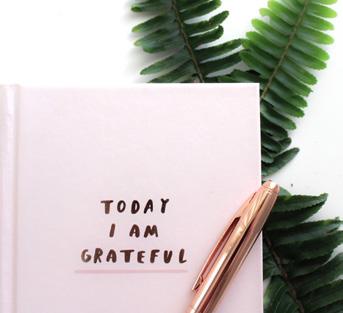
As a real life iron man, Chris Nikic has made history as the first athlete with Down Syndrome to finish the Ironman World Championships. The gruelling sporting feat requires competitors to complete a 2.4-mile swim, a 112-mile cycle, and a 26.2-mile run.
In a win for equality, a historic agreement has been reached in the US to pay the men’s and women’s soccer teams equally.
What does the future hold for emergency services? Potentially pioneering ‘Gravity Jet Suits’ that would drastically reduce response times for paramedics in search and rescue missions, which are currently undergoing testing in the Lake District.
Researchers in Australia have found a biochemical marker in blood that can help identify babies at risk of sudden infant death syndrome (SIDS).
Cancer Research UK has revealed that child cancer deaths have halved since the late 1980s, thanks to the UK’s world-leading trials and research.
Engineers from MIT have created ‘ultrasound stickers’, the size of a postage stamp, which allow pregnant people to watch their baby grow.
A life-changing invention being trialled in the UK sees ‘artificial pancreas’ technology support those with type 1 diabetes.
The end appears to be on the horizon in the fight against Covid-19 after the World Health Organisation shared that global weekly deaths fell to the lowest rate for two and a half years in September, in an optimistic sign that the pandemic might nearly be over.
Researchers believe a new blood test being trialled by the NHS could prevent one in 10 cancer deaths.
A new trial to support and empower older people with mental health needs in Lancashire and South Cumbria will see patients moved to a community care setting for six-weeks following discharge from a hospital, to assess what help they will require in a more natural environment. Participants will have access to mental health support workers, mental health nurses, a residential care team, and therapists, and will be given help with using digital technologies such as smart medicine cabinets, and video conferencing, to support their ongoing quality of life and independence.
A new suicide and crisis lifeline, ‘988’, officially launched in the United States.
A new poll suggests the secret to happiness is practising daily gratitude.
A touching video showed Jack Davey, who is registered blind, is on the autism spectrum, and has a condition called septo-optic-dysplasia, and his personal trainer and running guide, Joe Merry, being cheered on by family and friends as they took part in the London Marathon. Jack not only completed this gruelling challenge, but has raised more than £6,750 so far – you can support him at justgiving.com/fundraising/jack-davey9
Charity shop volunteer, David Flucker, commutes 12 hours a week to and from the St Columba’s Hospice shop in Edinburgh, Scotland – despite reaching his 100th birthday this year!
Following the Texas school shooting in May, Harry Styles and Live Nation pledged more than $1 million to nonprofit Everytown for Gun Safety.
Actor and WWE legend John Cena has set a new world record by granting 650 wishes for the MakeA-Wish Foundation.
Oscar-winning actor Russell Crowe saved a UK bookstore from closing down, after donating £5,000 and drawing widespread media attention to the shop. It’s been packed ever since!
After a passenger’s pet fish was banned from a flight, an employee of Southwest Airlines, Ismael, offered to take care of the fish for four months while the student returned home, ensuring she wouldn’t miss her flight. Now that’s tipping the scales on generosity.
In a true act of kindness, Franz Nigl, a farmer in Austria, shared about one fifth of his land (around 2.4 hectares) with his beekeeper neighbour, Josef Krenn, in order to return the space to wild meadows, as an “oasis” of insects and flowers.
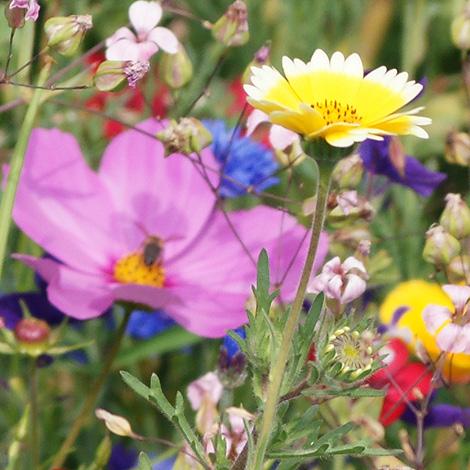
To counter loneliness, a supermarket chain in the Netherlands has introduced ‘chat checkouts’ specifically for those needing a social connection on their weekly shopping trip.
The community in Langholm, Scotland, pulled together in 2021 to buy local land in order to create a nature reserve. And now, a year later, they’ve outdone themselves by raising a further £2.2 million to double their current holdings to more than 4,200 hectares – ensuring the Tarras Valley Nature Reserve can provide a wealth of benefits to local people, wildlife, and the environment.
Dame Deborah James’s advocacy in her life was phenomenal, and so it came as no surprise that she used her platform and voice in her last days to fundraise and spread awareness of bowel cancer. Dame Debs’ legacy lives on, and her Bowelbabe Fund for Cancer Research UK has raised more than £7.5 million so far.
One evening each month, I can be found in the cosy cubby of a pub, spending the next few hours diving into the pages of that month’s read with a group of diehard bibliophiles. I’ve always felt that there was something romantic about book clubs, not solely in the sense that they make great meet-cutes for main characters, but because they feel old-timey and warm, and they are a means of coming together and connecting over what is normally a solitary hobby.
Book clubs open doors to new worlds, new genres, as well as to lasting friendships, and topics and experiences that you hadn’t previously considered.
Thinking about setting up your own book club? Here are some points to ponder and tips to help you get started.
What are you going to read? With so many options out there, how do you decide what you’re going to read? Well, you might choose to have a theme for your book club, for example, is
this club going to be devoted to minority or female writers? Or is it going to focus on a certain genre, such as crime books, or fantasy? Alternatively, the club could be devoted to working through prize lists, like the Booker Longlist.
If you don’t want to go so niche, you could consider changing the theme each month (romance, then translation, then a book set in your region), or find other ways to narrow the pool, such as only picking paperbacks under 300 pages. From there, you just need to figure out how the decision process is going to work – will you put forward options and allow the group to vote on which book they’d like to read as you go? Let a different person pick each time? Or will you take lots of suggestions from everyone, and allocate books throughout the year?

Who are you going to invite?
First things first, how many people do you want to have in your book club, and what kind of atmosphere are you looking to create? Do you want intimate chats, where each person has
space to freely express their thoughts, or are you looking to create a larger group where everyone jumps in and thoughts are bounced around?
You might have queues of friends and family who are keen to join the club and get reading – in that case, all you need to do is send the invites out. But if you’re looking to get to know new people, and connect with other readers over a shared interest, you might want to turn to the internet.
You can start your own group that people can search for on sites such as MeetUp, where others hunting for book clubs like yours are likely to discover them. Or you could try putting a call out in local Facebook groups.
Where are you going to meet? You might prefer the physical presence of your book clubbers, in which case you need a space to meet up. Would you like to come to an arrangement where you meet in each other’s homes, and take it in turn to host? Or would you prefer the neutral ground of a pub or other social space?
If you have a lot of people attending, it might be worth seeing what spaces are available to hire in your area – such as town and village halls, and other community hubs. These spaces may charge an hourly rate to hire, so depending on how much that is, you might wish to ask your group to chip in to cover the cost.
Alternatively, meeting online means that you can theoretically invite anyone, from anywhere in the world, to join the club. Lockdown introduced us all to a vast array of platforms to video chat across the globe, and many of us are now familiar with the logistics, making them a straightforward option.
How can you keep it accessible? Books can be expensive, particularly newly released hardbacks. That’s another reason you may choose to stick to shorter paperbacks, but there are other ways that you can cut costs, too.


For a start, if you have a longer lead time between each meeting, it may give people the opportunity to buddy up and book share. Libraries are also a great option – and, with enough notice, many libraries will allow you to request book purchases. Ebooks are another money-saving avenue and, what’s more, you can actually borrow ebooks from libraries for no cost. For those with visual impairments, those who struggle with text, or even those with a preference, audiobooks are another great option and readily available – plus, again, you can borrow audiobooks from the library.
It’s time to turn the page, create an open environment, and sit back and enjoy as ideas, thoughts, and feelings flourish together.

Recognise the physical signs that anxiety is affecting you
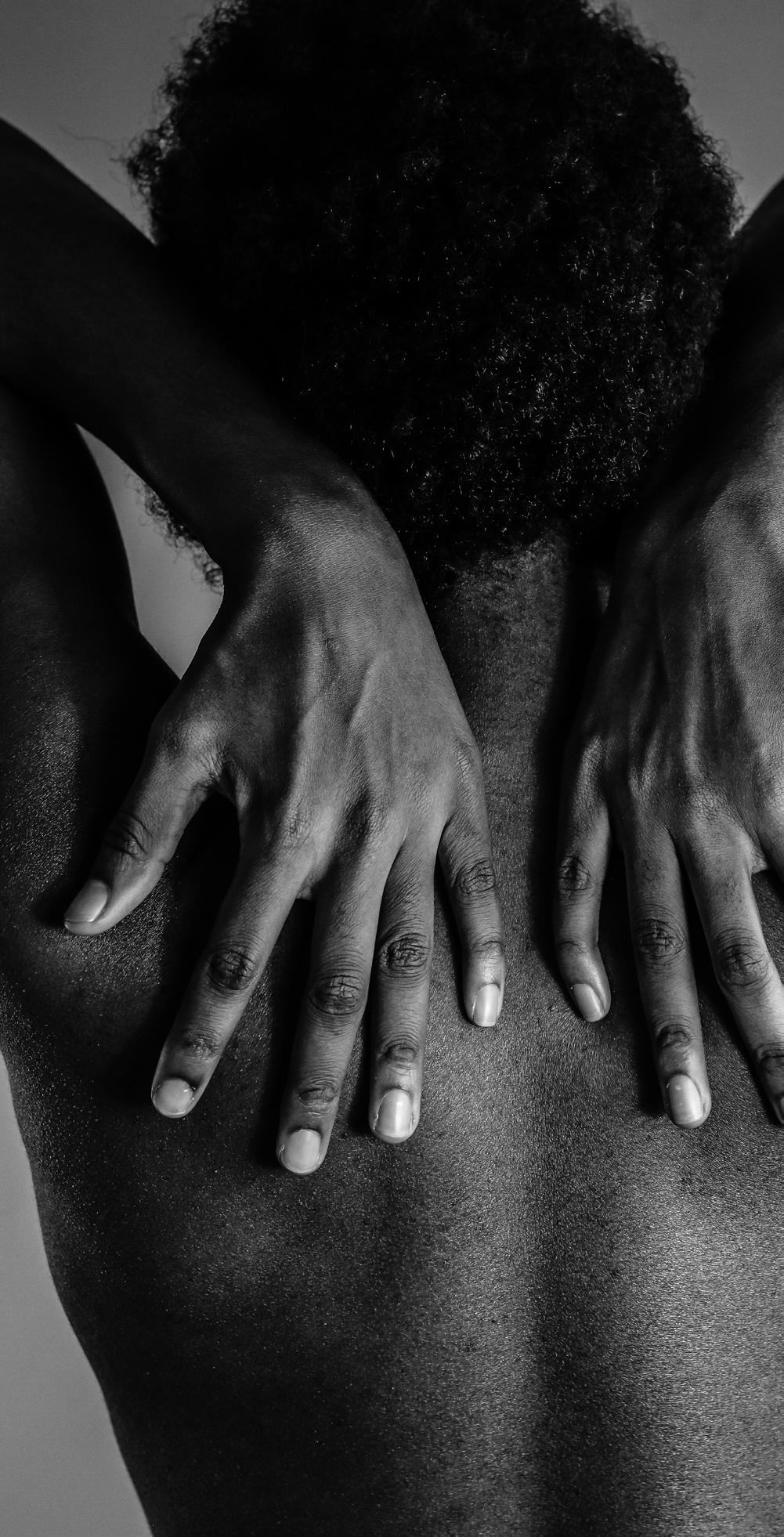
You might feel nauseous, and like there’s a churning in your belly, or that it’s in knots. Try to avoid caffeine, as that can make things worse. Instead, ginger tea can help settle you.
Your muscles might ache, being full of tension. A heat compress might help to soothe them, or resting up in a warm bath – magnesium can be particularly good for helping muscles to relax.
Your head could feel dizzy, or you might experience tension headaches across your brow. Practising meditation can be a good way to bring you out of stressful thoughts.
Anxiety might lead you to grind your teeth, or clench your jaw more. How about doing a deep, conscious breathing exercise?
Your chest may feel tight if your heart starts racing, or you start breathing more rapidly. Trying a mindful activity can help distract and ground you, to calm that pulse.
Note: If you’re ever concerned about symptoms, especially with chest aches or pains, please speak to your GP.
Eight months after The Wanted star Tom Parker died of brain cancer, his wife Kelsey reveals how embarking on an extreme walking challenge in the Sahara is the next step in her healing journey
Writing | Gemma CalvertThe weekend before her interview with Happiful, actress and influencer
Kelsey Parker was a guest at a wedding where she unexpectedly found herself sidelined by other guests.
“No one wanted to talk to me,” explains Kelsey. “People don’t know what to say to me, so they say nothing at all. I tried to speak to people that I hadn’t seen for a while, but after the ‘How are you?’ nobody wanted to take the conversation further.”
For the uninitiated, that conversation is grief. And, according to Kelsey, the widow of singer and The Wanted star Tom
Parker who died in March at the age of 33, after an 18-month battle with brain cancer, it’s time we all did better at speaking out about life after loss.
“I’m coping with my grief by speaking about it, but in the UK we just don’t talk honestly and openly about grief, death, and
everything else associated with these painful experiences. These are realities that will one day affect us all,” says Kelsey, who has made a six-part ITVBe miniseries about grief, which airs this month. Welcoming cameras into the south London home she once shared with Tom and their children >>>

Aurelia, three, and Bodhi, two, and being filmed as she explored alternative ways to navigate grief was, says Kelsey, “hugely healing”. As well as visiting a death cafe where people drink tea, eat cake, and discuss death, she tried grief yoga, where movements and breathing techniques help participants process their feelings. She also met with members of Widowed And Young, a national charity for people who are aged 50 or under when their partner dies.
“It’s shocking, isn’t it? I’m 32 and I’m a widow,” sighs Kelsey. “Although my friends are amazing, they can’t truly relate to me because they’ve not lost their partner, so I really enjoyed meeting with the WAY members because they truly understood where I was coming from, and that was lovely.”
With this in mind, you can sense the appeal of another activity that Kelsey is embarking on as part of her life journey post-Tom.
Alongside her close pal, actress and podcaster Giovanna Fletcher, TOWIE star Pete Wicks, and TV personality Vicky Pattison, this month Kelsey is trekking 100km across the Sahara in aid of breast cancer awareness charity, CoppaFeel!

Flanked by 100 CoppaFeel! supporters, the team will hike for 10 hours daily through Morocco’s unforgiving landscape, a gruelling challenge that would intimidate most. But not Kelsey.
From the day he was diagnosed with an inoperable grade four glioblastoma tumour in October
2020, during his 60 sessions of chemotherapy and radiotherapy, and until the day he died just hours after lying beside Kelsey and placing his platinum wedding ring on her finger, Tom never lost sight of hope. And now Kelsey says she is channelling her husband’s strength to complete the biggest physical challenge of her life.
up emotionally, and as well as looking forward to sharing “deep conversation” with her teammates, she is ready for deep moments of quiet reflection.
“It’s going to be a good, healing place for me,” says Kelsey. “There are things I need to let go of, things I’m still punishing myself for. I’ll think, ‘Why didn’t I do that for Tom? I should have done this,’ even though I know deep down there was nothing more I could have done. I guess it’s human nature to torment yourself with what ifs and self-blame.
“But the past two years have made me realise how strong I actually am, and that is a big motivator for getting through the trek. This experience has taught me so much. Oh my god…” Kelsey momentarily pauses.
“That’s so weird,” she continues. “A feather literally just fell on my car as we’re talking.”
“Nothing can be harder than what Tom faced during those 18 months,” she says, adding that she always admired his steadfastness under pressure.
“Tom had such a good mindset. He threw himself down mountains on ITV’s The Jump, and when he took part in MasterChef, he became a chef. Whatever the challenge, he always took on the task, and that’s what I’ve got to do. Get to the Sahara… and take on the task.”
Having hit the gym and packed in reformer pilates classes to physically prepare for the trek, Kelsey is gearing herself
Before Tom died, he promised to send Kelsey ‘signs’ of his presence. Minutes after he passed away at St Christopher’s Hospice in south London, a white feather fell from the sky onto a bench where Kelsey was silently weeping.
Recently, Kelsey says two framed pictures of the children have fallen to her bedroom floor.
“It doesn’t scare me. Thomas Parker never wanted to leave so I know he’s going to be hanging around, watching what I’m doing and guiding me. That’s hugely comforting,” she says, adding that although she has not had bereavement counselling, her own spiritual beliefs and deep
conversations with a spiritualist pal are helping her “reach a place of healing”.
As for the children, Kelsey believes in speaking “with honesty” to Aurelia – and, in time, Bodhi – about their father’s passing, and all the emotions connected to that loss.
“I don’t want them to ever look back and feel I’ve lied to them about anything because I’ve shielded them,” says Kelsey. “In the beginning, I explained Tom’s condition to Aurelia as ‘daddy’s got a bad head’, but now she’s a bit older, she’s overheard me talking about his brain tumour and now uses that terminology.

“At my friends’ wedding, she was a bridesmaid and had a picture of Tom on her bouquet. In the car on the way to the church, she was saying, ‘That’s my dad. He’s dead. He died of a brain tumour. He’s with The Queen now.’ The father of the bride was in tears.”
For all the decline that she witnessed during his last 18 months, Kelsey now mostly remembers only pre-cancer Tom.
“I think of the Tom before who would rock into a room with his quiff, going, ‘Alright!’ He was such a force, and I feel blessed to have shared such a closeness to him.
“We were so connected, it was like Tom had a radar to see where I was. Somehow, wherever I was, he’d turn up for half an hour, stop for a bit of lunch or dinner, then go off to the studio, and then pop up again. Even now in spirit, I feel he’s doing that. I know he will never leave me.”
I guess it’s human nature to torment yourself with what ifs and self-blamePhotography | Archive by Ryan courtesy of S Creative

No act of kindness, no matter how small, is ever wasted
What is it, why does it happen, and what signs should I be looking out for? We share everything you need to know about passive suicidal ideation
Writing | Bonnie Evie GiffordPassive suicidal ideation is something that many of us experience, but few seriously talk about. Perhaps the thought has crossed your mind, “I wish I could just fall asleep and not wake up,” or “I wish I could die, so I don’t have to deal with this.” These are examples of passive suicidal ideation and, while they are not active plans, and often focus on ways in which someone may die rather than actively cause their own death (such as thoughts of death through an accident or natural
causes, rather than suicide), these thoughts can be not only worrying, but can lead to engaging in riskier behaviour without being conscious of it.
Suicidal ideation isn’t an isolated event – it can be a symptom of other mental health issues, such as severe depression, or manic depression for those with a bipolar disorder diagnosis. Here, we’ll explain more about the different types of suicidal ideation, warning signs to look out for, and, crucially, how to then find help.
Having suicidal thoughts is a spectrum. For some people, these thoughts may be active: they think about suicide, and may have developed a plan for what they will do. They want to die. For others, it may be passive: they wish they were dead or could die, but do not have any concrete plans.
Neither kind of suicidal ideation should be dismissed. You are still at risk of harm if you have passive suicidal thoughts. >>>
Intent and motivation can change quickly, meaning you may not feel at risk now, but that could change before you realise it or have time to seek help. Studies have suggested that if you experience high levels of depression and suicidality, thoughts of passive and active ideation have the potential to become more severe and dangerous. Experiencing physical illness, a significant decline in your mental health, or an unpredictable event (losing your job, a particularly bad day, fighting with a loved one) could trigger your thoughts to become active.
Passive suicidal thoughts are more common than many of us realise. Worldwide, around 9% of us will experience suicidal ideation at some point in our lives. Within the past 12 months, that sat at around 2%. One US study found that 4% of adults aged 18 and over have thought about suicide, with those aged 18–25 the most likely to have had such thoughts within the past 12 months.
As of 2020, around 10 in every 100,000 deaths were contributed to suicide in England. For men, that rate was much higher (15.3 per 100,000) compared to women (4.9 per 100,000). Men aged 45–49 have the highest suicide rate (23.8 per 100,000). Worldwide, the World Health Organisation
estimates that one in every 100 deaths is a result of suicide.
All this to say, suicide is something that has touched many lives, and it’s something that we need to take seriously.
than others?
While men are three times more likely to complete suicide, research suggests that women show higher rates of suicidal thinking, non-fatal suicidal behaviour, and suicide attempts.
You may be at higher risk for suicidal ideations if:

• You have a personal history of mental illness (particularly
depression, bipolar disorder, or other mood-based disorders).
• There is a family history of mental illness (suicidal thoughts or attempts, depression).
• You have experienced substance addiction.
• You have a history of abuse, or have experienced significant trauma.
• You exhibit impulsive behaviours or increased aggression.
• You have a physical illness.
• You have experienced a major loss (death of a close friend or family member).
• You have limited access to healthcare or a support network.
Sometimes people can struggle to recognise warning signs of suicidal thoughts or behaviours. Signs that people often overlook can include:
• Feelings of being empty, hopeless, or like you have no way out of your problems.
• Strong feelings of guilt or shame.
• Believing that others would be better off without you.
• Becoming withdrawn or isolated socially.
• Unexplained changes in how you sleep (e.g. struggling to get out of bed, sleeping more, sleeping less, staying up all night then struggling to cope the next day).
• Becoming emotionally distant from others (e.g. seeming indifferent when faced with emotional situations like the loss of a pet, or when receiving particularly good or bad news).
Seeking help and advice is recommended. Speaking with your GP can be the first step towards getting a full assessment and diagnosis. This can help you to access the right kind of help and support, better understand what may have led to you feeling this way, and find new ways of
coping with these feelings, and addressing any triggers.
Experiencing any level of desire for death can lead you to unconsciously act in a way that may be riskier to your health and wellbeing. Even when passive suicidal thoughts remain passive, they suggest a level of unhappiness and discontent in your life, and risk negatively impacting your overall wellbeing and quality of life.
Reaching out for help is the first step to overcoming these thoughts and feelings. You don’t have to live with these thoughts, and you also don’t have to face them alone.

There are a number of options that may be recommended, depending on your circumstances, symptoms, and what services are available in your local area.
Talking with your GP is often the first step towards getting a referral for specialist mental health services in your area, as well as talking through any medication options that may be worth considering. They may highlight local support groups you could access. >>>
For some people, your GP may prescribe antidepressants or anti-anxiety medication to help decrease symptoms while you are working through the underlying causes that are triggering your thoughts in therapy.
Counselling (therapy) is often highly recommended, as this can help you to identify the complex issues that may be causing the way you are feeling, help you to understand your thoughts and feelings better, as well as introduce you to new ways to manage your thoughts in a more productive or useful way.
Dialectical behaviour therapy (DBT) in particular can be helpful for those experiencing suicidal thoughts, as it uses acceptance and change techniques that can help you better understand

why you’re feeling this way, and what you can do to help yourself. Other types of therapy may also be suggested, such as cognitive behavioural therapy (CBT).
Talking with others who have had similar experiences can be a huge help. Reaching out to find online support networks can be the easiest way of doing this, or there may be support groups in your area.
Typically suggested for when you have active suicidal thoughts, it can be helpful to have one in place just in case. A safety plan may include listing any warning signs you or others can look out for, writing down coping strategies that could help, as well as listing the contact details for who you want to be contacted in the case of
an emergency. Ensuring you know the steps you need to take to keep yourself safe can help you to feel more prepared if your thoughts do take a concerning turn.
Talking to your friends and family can help you to better understand how you are feeling, as well as to let them know that you are struggling. If you are worried that your thoughts or feelings may have been causing you to withdraw from others, this can be a helpful way to reach back out again to them.
What can I do if a loved one is experiencing passive suicidal ideations?
If you’re worried about someone, one of the most important things you can do is listen to them, without accidental judgement, or minimising how they are feeling – ask questions, and ensure they know that you are there to offer support.
Don’t promise to keep their suicidal ideation a secret. Doing so can not only harm their trust in others if you do need to speak out and seek help on their behalf, but it may also make you hesitate. Encourage them to seek help, but avoid pushing them before they are ready. Offer to drive them or go with them if they feel worried about going alone.
If you are concerned about their immediate safety, call 999 or take them directly to A&E.
Encourage them to seek help, but avoid pushing them before they are ready
31 days of self-care Take a moment each day to refill your cup. What do you need today?
an 17 23
Explore the outdoors Phone a friend
Start a new skill you’ve always wanted to try Declutter your social media feeds 15 21 27
9 10 11 12 13 19 25 31
help Visit somewhere you’ve never been Write your bucket list Do a surprise act of kindness Find a new way to use one of your strengths Embrace ‘good enough’, and let go of ‘perfect’ 18 24 29 30
Pay yourself three compliments Carve out some time to get creative Go screen-free for a day Give yourself a break Tidy up a space in your home Do something that brings you joy 16 22 28
Write down three things you’re grateful for
Get creative and express yourself

When the time comes to be intimate again following childbirth, it can bring up complex feelings. Here’s how to work through them…
Writing | Ella Delancey Jones Illustrating | Rosan MagarBirth is a powerful and incredible feat, and bringing a child into the world is arguably one of the most life-changing things a person will ever do. But childbirth takes its toll on the body, both physically and emotionally – not to mention the months of pregnancy beforehand, which stretch and push your body to, what feels like, its limits.
Once your little bundle of joy is safely home, you begin the journey of learning how to navigate your lives as a couple,
while simultaneously doing your best to take care of your baby.
It may be the last thing on your mind for a while, but there may come a time when you’re ready to resume sex with your partner.
For some, sex is an important part of growing and maintaining not only a physical connection with their partner, but also an emotional one.
Thinking about the actual event, however, can be daunting.
If you’ve had a particularly traumatic birth, stitches or tears (or even if you haven’t), it’s normal to have some anxiety around sex
after pregnancy and birth. Here are five simple and effective steps to help ease your worries.
1. Don’t push yourself
Although it’s best to wait until you’ve stopped bleeding before you start having sex again, after a straightforward birth it’s likely that your GP will ‘sign you off’ at your six-week check for physical activity – which includes sex. However, it’s important that you don’t view this as a ‘must-do’, unless you really feel ready.
Leah Hazard, midwife and author of Womb says: “It’s
dangerous and unhelpful to think of the six-week check as a time when women get some kind of professional permission or validation to resume penetrative sex. There is no one-size-fits-all approach to intimacy: every body is different, and every timeline of recovery and readiness is different.”
2.
A baby makes you busy. So busy, in fact, that it’s all some of us can do to lie on the sofa mindlessly scrolling on our phones for an evening. But carving out a little time for intimacy – kisses, cuddles, holding hands – can help you feel much more connected with your partner, and allow you to remember the sweetness at the core of your relationship, outside of dirty nappies and feeding schedules.
Leah says: “Some people will feel emotionally and physically ready for intimate touch just a few days after birth, while others may not feel that way for many weeks or months. Both approaches are fine. It’s important to give your body and mind time to adjust, and it’s also helpful to remember that a
nurturing physical relationship with your partner doesn’t have to involve penetration, or even genital contact.”
3. Ensure you’re completely ready Vaginal dryness is a common cause of painful sex after giving birth, and it’s really key not to push yourself if you’re hurting. Even if you’re in the middle of what you thought might be your first time back between the sheets with your partner, you should press pause on things if you’re feeling uncomfortable or in pain. It’s important that your partner should be respectful and understanding of this. Buying a water-based lubricant can really help!
4. Don’t go ‘all the way’ There are so many ways to be intimate with your partner which don’t involve full, penetrative sex. Engaging in some foreplay is a fun and exciting way to reintroduce sex into your relationship, while also easing the anxious thoughts you may be having about painful or awkward intercourse.
Open communication with your partner about your boundaries is important here.
5. Get some help Leah says: “If you feel that there’s a specific issue with your physical recovery – either with your perineum or your caesarean section wound – do speak to your midwife or GP to see if treatment is required.”
Emotionally, if your anxiety is too much to handle when it comes to thinking about resuming sex, it’s important you look into getting some support, likely from your GP who may refer you for talking therapy. Close friends and family can also be a great help if you’re finding things difficult. Please don’t suffer in silence.
In short, there are no hard rules for resuming sex after childbirth. You should set your own timeline, go at your own pace, and only do what feels right.
There is no one-size-fitsall approach to
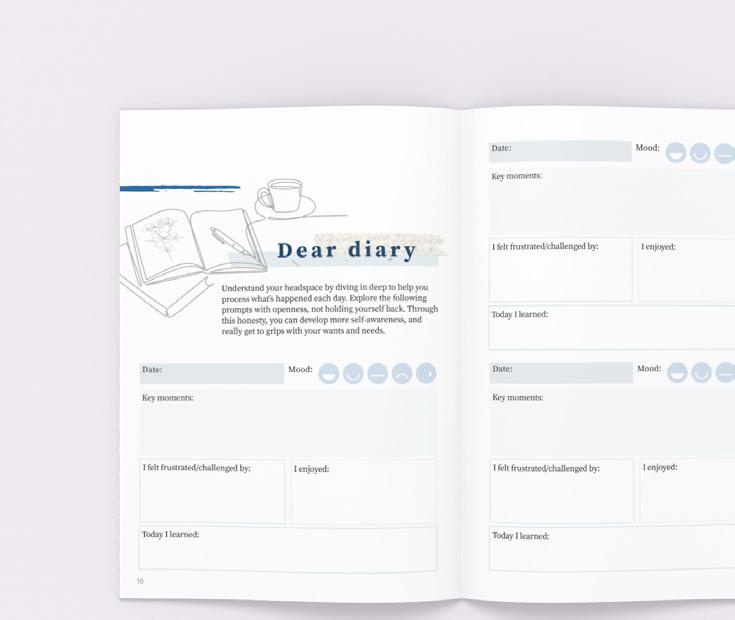
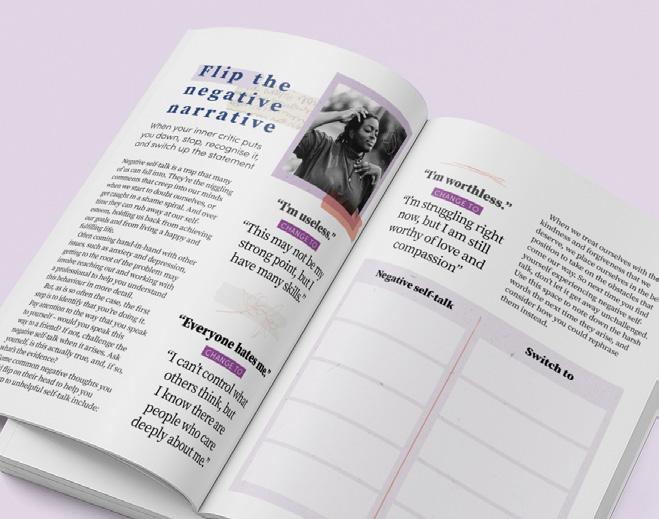

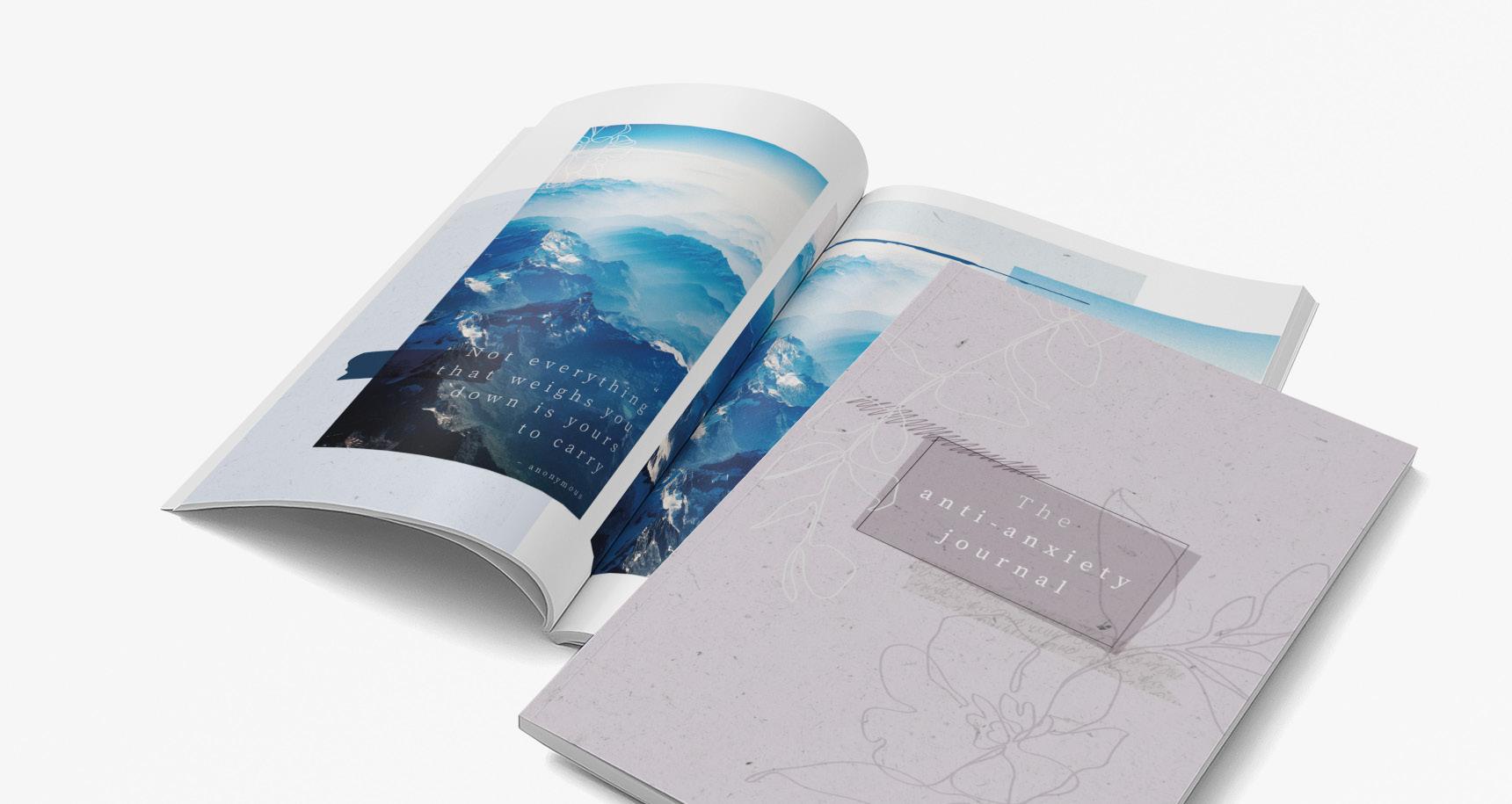
It may seem natural to not want to let someone off the hook for what they have done, but be warned –these bitter feelings can hurt you too
Writing | Kate OrsonYou may have heard stories about people forgiving others for the most heinous of crimes, things that seem unimaginable to you – betrayal, lies, scandals, and even felonies. You may have wondered how on earth could they do that? Many of us hold grudges from the past, or feel that to let go and forgive may send the message that we condone wrongful behaviour. So, why is it that some people find it easy to forgive, and others seem to struggle?
When comedian Chris McGlade heard from police that his father had been murdered, he forgave his killer in an instant. To help me understand why, Chris told me of his upbringing with a father
who had an irreverent sense of humour, and didn’t take life too seriously.
“He was the most outrageous man, with the most outrageous sense of humour, but a massive heart. There was never any malice in him, and he always forgave, and that left an indelible mark on my life.”
Chris says that at the moment the police told him the news, an “irreverence came over me”. At this darkest of moments, he made a joke. When the police looked surprised, his wife said: “Oh, it’s just his way.’’
He reflected: “It was my way, but more importantly it was my family’s way, it was my dad’s way.’’ >>>
Chris felt the presence of his father in that moment. He says: “I could see him in my mind’s eye saying ‘Go on, that’s what you do. You laugh, you don’t get angry –protect yourself with a laugh,’ and at that moment, I felt this love. It wasn’t something I had to think about, it was just instinctive.’’
Chris is now touring with a comedy show, Forgiveness, about life growing up with his dad, and his decision to forgive his father’s killer. His story is an extremely unusual case.
Most of us go through life, carrying resentments and grievances from various experiences. It may seem natural to not want to let someone off the hook for what they have done to us, but the problem is that these feelings hurt us, too.

In her book, Forgiveness Made Easy, life coach Barbara J Hunt explains how the word ‘resentment’ comes from the Latin, ‘sentire’ to feel. ‘Re-sent’ literally means, ‘to feel again’. When we hold on to feelings of resentment, we are stuck in a ‘pain loop’, feeling all of the old emotions, again and again, like a wound that never heals. One study published in the journal Aging and Mental Health found that unforgiveness can cause depressive symptoms later in life.
Forgiveness, on the other hand, has a wealth of physical and emotional health benefits, including reducing levels of anxiety, depression, and stress, lowering blood pressure, lowering cholesterol, and improving sleep. First and foremost, forgiveness is for you.
One major stumbling block Barbara J Hunt explains in her book is our ego. In order to protect ourselves, we keep our emotions of hurt hidden under the shell of our ego. Feeling resentment allows us to focus on what the other person did wrong, rather than fully feeling our own pain and grief.
This attitude is the cultural norm. Hunt says: “Think of all the soaps, movies, and literature where resentment is part of the plot, or the saying, ‘Don’t get mad, get even.’ It can feel enticing to be the victim, and hold on to the person’s wrongness.”
This isn’t to negate the fact that we have been hurt, often by another’s mistakes. However, holding on to resentment stops our ability to heal from the hurt. The first thing to realise is that forgiveness is for you, not the other person. It doesn’t mean you have to necessarily let the person back into your life. It simply means you can heal from the emotions that leave you trapped in resentment.
In order to forgive, you may need to process the feelings of hurt that are stopping you from letting go. It is important to honour these emotions, to give them the time and space they deserve, so as not to minimise what happened. Although Chris McGlade did forgive instantly, he also worked with a counsellor, and told his dad’s story through his comedy.
How would you like to make space for your feelings? It could be with a therapist, a journal, or an understanding friend.
One way to start is to spend 10 minutes journaling on the topic of resentment. What resentments are you carrying? Do you hold anger and blame towards people who have hurt you? Follow your train of thought, and write everything down in a stream of consciousness.
Reread your list, and notice what feelings are there. What would you say to this person, if you could have a totally honest conversation? If you didn’t have to censor yourself? Set a timer, and allow another 10 minutes to express yourself. Let yourself be as petty and immature as you like, without judgement.
As you go about your life, notice when feelings of resentment come up. Allow yourself to fully feel them. Express yourself and have a good cry, or a talk with a friend. Notice any habits of trying to distract yourself – with comfort eating, or scrolling through social media, for example. If it feels like too much to process on your own, then find help from a therapist or counsellor.
Mainstream culture may encourage people to hold on to resentment, but seeking literary or film inspiration on the topic of forgiveness can be a powerful antidote. Check out books like The
Kite Runner, by Khaled Hosseini, about a man seeking atonement for not intervening in a rape, or The Art of Mending by Elizabeth Berg, about forgiving family members for life-long hurt. Or watch films like Dead Man Walking, the story of a nun who became a spiritual counsellor to a man on death row, or A Thousand Acres, a film depicting sibling hatred, forgiveness, and love. Other people’s stories can be a cathartic way to explore your own hurt. Many audience members at Chris McGlade’s show have been inspired to let go of their own grudges.
Then, when you’re ready, try journaling on the topic of your best life. How would it be without resentment, without any trace of anger? Do it not for the person who hurt you, but for those you love. As Chris says: “I’ve got three grandchildren and a daughter, and when you’ve got other people who love you, and care about you, you have a responsibility. You have a duty of care to those people, to be the most peaceful and loving person that you can.’’
This doesn’t mean putting on a brave face, and burying the feelings, but taking the time and attention your feelings truly deserve to authentically let go.
Feeling resentment allows us to focus on what the other person did wrong, rather than fully feeling our own pain and grief
From a lesson in upcycling to a botanical winter walk, and a podcast about the latest films, try something new with our enriching suggestions
Writing | Lauren Bromley-BirdHelp an elderly person stay warm this winter
It’s no secret that we will all be looking for inventive ways to keep ourselves warm this winter amid the cost of living crisis and cutting back on heating bills, but it’s especially important to help elderly individuals in any way we can. If you know someone that will struggle this winter, you could donate a blanket or hot water bottle, or invite them over to warm up at your place and have a nice catch-up.
Chatter: The Voice in Our Head (and How to Harness It) by Ethan Kross

We often have a tendency to be our own worst critic, with negative self-talk sending us into a spiral of self-doubt. But how do we harness this and take back control? Award-winning neuroscientist and psychologist Ethan Kross provides us with the tools needed to befriend our inner voice, and turn it into something more productive. (Out now, £10.99)

Visit a botanical winter garden
‘10/10 (Would Recommend)’
Are you having trouble deciding what to watch on TV? Hosts and best-friend duo Gena-mour Barrett, who works for Netflix, and Tolani Shoneye discuss the latest mustsee films and guest recommendations to help you beat indecisiveness on your cosy night in. (Available on all podcast platforms)
Travelling around the world is something many of us dream of doing, but how much better would it be to bring your pet along for the ride?
With the winter season upon us, there is no more magical a time to visit a botanical garden. Take a brisk walk through the gardens, and explore the seasonal plants and wildlife. It’s a wonderful place to learn about nature and embrace the wonders of winter, all while reaping the wellbeing benefits of the outdoors. (Search for botanical winter gardens in your your local area)
Lawyer Dan Nguyen went viral on Instagram after documenting his heart-warming travels across the globe with not one, but three cats. Follow their daily adventures if you need to put a smile on your face. (Follow @spongecake_ thescottishfold on Instagram)
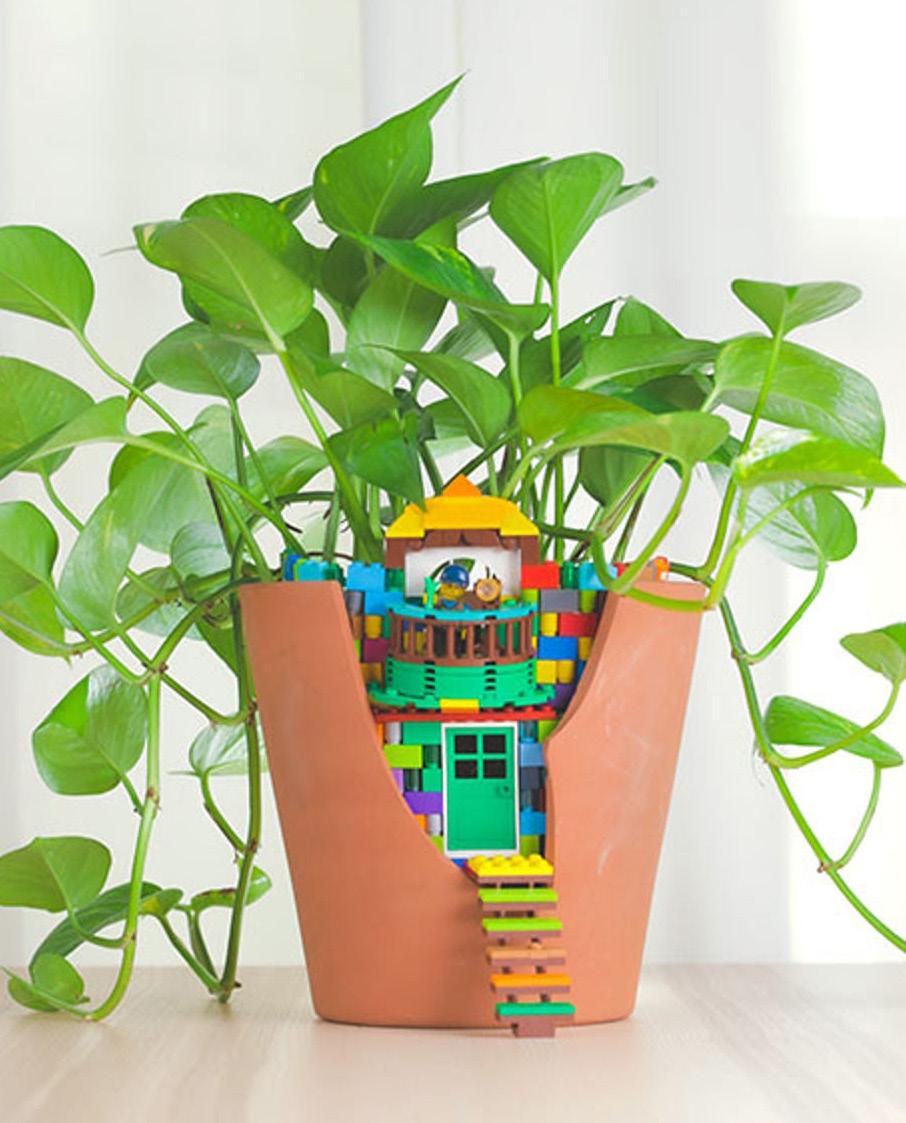
Do you have a broken piece of furniture that you’re going to throw away? Maybe you have some Lego lying around, that your children played with once and never again? Get creative and use Lego to repair your broken household items, and be part of the revolutionary growth of upcycling. (Visit lego.com to find out more)
In a technology-driven world, it’s easy to compare your life with others on social media, but a change is coming. This innovative app is designed to reduce social pressures by allowing users to only post one photo a day within a two-minute window. The idea is to encourage people to connect more authentically, posting a photo at that moment, with the motive to ‘be real’. (On the app store)
What’s more festive than running a 5 or 10K dressed as Santa Claus? Suitable for all ages and abilities, the seasonal fun run will have you working up a sweat to raise money for your chosen charity, while spreading community Christmas cheer. (Visit thesantaruns.com for more information)
Twelve ambitious candidates, each with their own political beliefs, compete to become Channel 4’s ‘alternative prime minister’. In a test of integrity, leadership, and resilience, they face former politicians, experienced journalists, and the public in challenges that mimic the duties of a prime minister. Do they have what it takes to become a true leader? (Available to watch on E4)
Is it possible to eat delicious chocolate that is organic, gluten-free, and vegan friendly? It certainly is with Kyoot! The brand prides itself on its principle-friendly chocolate, and we are all for it. From five wildly different flavours to choose from, including raspberry and pink pepper, and vanilla quinoa pops, indulge in the delightful treat that gifts guiltfree happiness. (From £12 at eatkyoot.com)

For your chance to win, simply email your answer to the following question to competitions@happiful.com
According to studies, which hormone does chocolate release? a) Melatonin
*Competition closes 31 December 2022. UK mainland and Northern Ireland only. Good luck! T&Cs apply.
Get into the seasonal spirit by trying your hand at making a budget-friendly, nature-inspired wreath
Writing | Rebecca ThairWhether you’re looking to carve out a mindful moment in the day for yourself, or for a fun activity to keep all the family entertained, and spend some quality time together, wreathmaking can be a fantastic way to celebrate the holidays.
But getting crafty isn’t just a fun pastime; getting creative, regardless of what medium you explore, has been scientifically proven to reduce stress, boost your mood, and improve selfconfidence. Plus, you have the added sense of achievement from creating something from scratch, which can be all the more meaningful, too.
When it comes to wreathmaking in particular, you can put your own take on a traditional activity, and work to a budget by finding natural, free elements to include from your own garden, which can make it a great way to engage kids without breaking the bank over the holidays. But one key note is
to always be responsible – ensure you pick items from your own garden, public spaces, or have permission if on private property – and take only what you need to avoid waste.
The good news is that, while most commonly associated with the Christmas period, wreaths can be a wonderful addition to brighten up your home throughout the year – changing colours and natural elements with the seasons. So, if you love taking your hand to wreath-making this winter, it can be something to look forward to again come spring – be-wreath me, it’ll be here before you know it!
• A wreath base
• Scissors or secateurs
• Moss
• Greenery
• Decorative elements
• Ribbon, string, or florist wire
Before you get crafty, take a stroll outside to collect some seasonal treasures. This could be anything from pinecones to berry sprigs, acorns, leaves, or scraps of bark to decorate your wreath. Depending on how much you find, or the look you want to go for, you could create a classic, full wreath, bursting with greenery, or you might want a more minimalist take and decorate just a portion of the wreath, leaving the twisted willow base on display.
Plus, if you’re struggling to find decorative elements out in nature, don’t worry. You could always hang some spare baubles instead of using pinecones, for a fun pop of colour.
Method:
1. To begin, you’ll need a wreath base – you can buy these pre-made from stores like Hobbycraft, which are usually created from wire or rattan, and cost less than £5.
Alternatively, you could craft your own by repurposing materials from around your home, or twisting together willow or vines – anything that you can turn into a makeshift hoop to form the base of your design.
2. Take your choice of ribbon, string, or florist wire, and thread this through a section of the wreath to create a loop you can hang it up from. Wherever you create this loop will form the top of your design, so keep this in mind moving forwards.
3. A good first element is moss, which you can secure using more florist wire. This can help add some dimension as you layer other items on top, and can disguise the base of your wreath.
4. Scan over your collection of greenery from the outdoor scavenger hunt – this could include fir tree sprigs, ivy, holly, bay leaves, or rosemary, for example. Select a range of pieces that you can gather together in a small bunch to create more volume, and wrap more florist wire around it to secure. But remember to be careful to avoid pricks if you’re using holly – gloves might be helpful!
When you’re attaching these sprigs, follow the shape of the curve to create a fan effect as you go around the circle, with the edge of the greenery spraying away.
5. Continue doing this around the rest of the wreath, ensuring you overlap the elements to create fullness. You could try to mimic the first bunch as closely as possible if you prefer a more uniform look, or shake it up and choose pieces at random if you want something more natural looking.

6. Once you’re satisfied with the greenery, it’s time to add the decorative elements. For some of the more delicate pieces, you might be able to poke through the existing structure to secure, but for heavier items like pinecones, you’ll want to bring out your trusty florist
wire again. One thing to note is to be careful of edible items such as berries, especially around kids and pets – we love curiosity, but only if it’s safe! As well as elements from a woodland walk, you could include other seasonal favourites you can buy, such as cinnamon sticks; or bake orange slices to dry them out and use for a pop of colour, and a full sensory experience with that added scent.
7. For a finishing touch, add a bow with a ribbon in the colour of your choice! Now, it’s time to put it on display and enjoy the festive spirit.
When you’re having an ‘off’ day, finding the energy to eat well can be a challenge – but fuelling ourselves properly is one of the best ways to get back to our best selves. Here, expert columnist
Claudine Thornhill shares essential tips to keep you nourished, even when it’s been a long day…

Off days are inevitable, and they tend to negatively affect our eating habits. Even the most diligent of meal preppers, balanced eaters, and foodie types can be caught out by having an ‘off day’.
As a nutritional therapist and health coach, I work with women who are spinning multiple plates, due to busy careers, sometimes alongside thriving businesses or side hustles, busy family lives, caring responsibilities, and commitments at home. And that’s on top of trying to maintain social relationships, and cultivate hobbies and interests. I see many people struggle with catering to their own needs, even those as basic as eating well.
On those days when you’re feeling uninspired, unmotivated, have low mood or low energy, are stressed, overwhelmed, or simply off, just coming up with nourishing meal ideas can feel like a mammoth task, never mind conjuring up the energy and
patience to stand in the kitchen and actually prepare the meal. It’s tempting to reach for the quick and easy fixes – the crisps, chocolate bars, pastries, and biscuits to fill that hunger gap, and it makes sense. The fat and sugar content of these foods provide a quick dose of energy, albeit short-lived. It’s equally tempting to reach for the array of options that come in a few clicks on a food delivery app. The evidence shows that people are less able to make healthy choices when they are stressed, tired, and hungry, and although there are some great balanced options you can order online, it’s more likely that the high fat, sugar, and starchy carb options will stand out.
So, what should we do when we really can’t be arsed, but still want to nourish our bodies? Here are some proven tips that work.
Firstly, don’t get caught out by an empty kitchen. We’ve all been there, standing in front of the open fridge door, searching for
inspiration, but it’s unlikely to come if the fridge is empty. Set yourself up for success by having quick and easy staples to hand. These might include couscous, rice noodles, tinned tomatoes and tomato puree, spice pastes, tinned beans, frozen vegetables, fresh soups, and flatbreads including pitta bread – these are also great freezer options. Have a tasty curry ready in 15 minutes by combining your frozen mixed vegetables, tinned chickpeas, curry paste, tomato puree, and a little water. Your curry can be served alongside flatbread or couscous. Similarly, throw frozen mixed vegetables in a pan, and combine with rice
noodles that have been soaked in boiling water, add soy sauce or tamari, peanut butter, and whatever spices you have to hand, and you’ll have a tasty noodle dish in a similar time.
Harness the energy of when you’re firing on all cylinders to prepare for those off days.
Leveraging the times when you’re super productive means that you could pre-wash, peel, and chop your vegetables so that they are ready to go when you are. You might cook a few extra portions of a meal, and put some aside
to keep in the fridge or freezer.
You could also use the same ingredients to make two different meals, one of which can be called upon on an off day.
We have to dedicate some time to one of the most versatile foods: eggs. With their healthy fats and protein content, eggs will provide you with energy and keep you full. Their versatility is an added bonus, from a lazy boiled egg with a slice of toast, to more sophisticated omelettes, or a fancy shakshuka using tinned tomatoes and beans, eggs are the full package. Egg
muffins make a tasty breakfast or a snack option, and can be stored in the fridge for a few days. Cook whisked eggs in a pre-oiled muffin tin, add cheese, veg or salmon, and herbs of your choice.
Snacking is where a lot of people can sabotage their health goals. Although eating full meals reduces the urge to snack, preparing balanced and nourishing snacks can ward off hunger for a few hours. Some options to keep in the back pocket are hummus and sliced tomatoes on corn cakes, peanut butter stuffed dates, Greek yoghurt with berries, apple slices with almond butter (add a little salt and cinnamon for extra flavour), popcorn, nuts, or a fruit platter.
Off days happen to the best of us, but let us eat well while we’re feeling off.


It’s time to tackle taboos, as we put your most pressing gut health questions to the experts to get some much-needed answers
Writing | Ellen Lees & Linda AlbinssonIt happens to all of us. Sometimes, you wake up and something just doesn’t feel right. Sometimes, it can catch you off guard, you could be enjoying your morning coffee and oop – you need to move, quickly. Sh*t happens. So why are we so ashamed of talking about it?
It’s no secret that our gut health needs to be looked after, but how much can we really know when the majority of us aren’t comfortable asking those all-important questions? Well, we’ve asked them for you. Linda Albinsson, head nutritionist at London’s Advanced Nutrition Clinic, answers some of the most commonly searched questions related to our guts and bowel habits. It’s time to talk sh*t.
Is gut health really so important?
It’s really the root of everything. Your gut bacteria impacts your
metabolism, oestrogen, your mental health, bone health and longevity! And time and time again, I see gut issues on those with eczema and skin issues, inflammatory conditions, and pain conditions such as joint pain, headaches, etc. Though we don’t always see gut symptoms in these clients, so stool testing can be useful here – it’s possible to have chaos in the gut, but be almost completely asymptomatic.
How do you know if you have bad gut health? Watch out for wind and changes in bowel movement.
If you’re unsure, have a look at the Bristol Stool Chart – this breaks poop into seven types, with three and four considered ‘normal’ (fairly smooth, sausageshaped). Some people can find it a little difficult to work out where they are on the chart, especially if your stool varies from day to
day. Really, you want your poop to be consistent and very similar in shape.
Many of us have a sluggish gut, which means we’re likely not fully eliminating. If you’re only going to the toilet once a day, for example, and it’s not ‘100% complete’, you’ll quickly get a jam. And if, when going to the toilet, your elimination feels more like the work of gravity than muscular movement, it’s possible that you’re not properly eliminating.
Constipation is also a common cause of wind and bloating, and, believe it or not, fatigue! The sweetcorn test can be a useful home assessment to investigate the speed of your gut transit.
Are there specific foods that help gut health?
Fibre is by far the most important element in gut health, as this is what feeds your ‘good’ microbes. >>>
But fibre is a double-edged sword. If you don’t have enough of the good bacteria in the gut, fibre might just be the thing that’s causing you wind, bloating, and changes in bowel movements.
Polyphenol is one of my favourite microbiome-building foods, as it is so well-tolerated and has anti-inflammatory and protective benefits. Fermented foods, such as kvass made with berries, can be helpful, though these should be avoided if you
WE DON’T ALWAYS SEE GUT SYMPTOMS, SO STOOL TESTING CAN BE USEFUL – IT’S POSSIBLE TO HAVE CHAOS IN THE GUT, BUT BE ALMOST COMPLETELY ASYMPTOMATIC
have irritable bowel syndrome (IBS) or small intestinal bacterial overgrowth (SIBO).
Cloves are also good for gut health, as they are a powerful, natural antimicrobial, and can be really useful to treat symptoms like wind, without the need for expensive supplements.
Is it true that gut health affects the immune system?
One of the most forgotten and ignored gut element is the lymph system! The lymph has an important immune system function, and much of it in the gut sits just by the lining, ready to patrol the area. It’s no wonder a compromised gut mucosa or insufficient beneficial bacteria can allow microbes and intruders to trigger the immune system. In fact, I often find the presence of SIBO or overgrowth of ‘bad’ bacteria in clients with inflammatory conditions, such as arthritis.
Is gut health important for weight loss?
We know that, in obesity, the microbiome is often ‘disturbed’ or imbalanced, with a particular type of pattern of bacterial groups. Some bacterial groups are associated with weight gain. Something I often observe in the clinic is that people who come to me with either SIBO or chronic constipation will complain of unexplained weight gain. They are often the type of
person who has tried everything and lives on a restricted calorie diet, yet sees no change in weight whatsoever. When we work on the gut however (which may also include working on the liver), and the diet and insulin response, the person will find that their weight responds better to their true dietary intake.
Are probiotics worth it?
Yes, probiotics are an invaluable tool in gut treatment. But one thing probiotics don’t do is become ‘added to your microbiome’, so to speak. The bacteria will hang around in the gut for a while, and be beneficial while it’s there, but it’s not for ever – which many people don’t realise.
To improve your gut microbiome long-term, you need prebiotics.
I am a huge fan of prebiotic supplements as opposed to their food form (e.g. artichoke, chicory, and chickpeas) as you can control the dosing properly, and avoid the risk of aggravating symptoms. With supplements (and the support of a professional), you can slowly increase the dose over a longer period of time, in line with tolerability.
There are instances where prebiotics should be avoided, however. If you have very severe and reactive wind and bloating, you may find that many types of prebiotics cause even more wind. In this case, you’d want to consider SIBO or what the digestion is doing (the gallbladder and stomach acid in particular)
The sweetcorn test involves avoiding corn for a number of days to ensure the gut is clear of kernels. Then, introduce some corn into a meal. Note the time of eating, and wait for the magic to happen. How soon you see corn in your poop can indicate the functioning of your bowel – in an ideal world, you’d expect to note the corn between 24 and 36 hours after eating, as a rough guide. If you spot it in less than 12 hours, you may have diarrhoea, and longer than 36 could be a sign of constipation.
and treat this first. For this, I would always recommend a stool analysis or SIBO test, so that treatment can be tailored.
As more research has developed, we are gaining an understanding of specific strains being beneficial for particular areas of the body; including bone health, skin issues and liver health, so matching the right strain to the condition is key.
Linda Albinsson is head nutritionist at London’s Advanced Nutrition Clinic, specialising in gut dysfunction. Find more on her profile at the Nutritionist Resource.

It can be incredibly tough to see your child going through self-harm. From a mother who has experienced it herself, we share steps for supporting them on their journey
Writing | Gabrielle Gapproach the subject in terms of making sure wounds are clean, and seeing if medical attention may be needed.”
mechanisms that can be tried: elastic bands, red pen, butterfly drawings (check out the Butterfly Project, butterfly-project.tumblr. com).
When my child was 10, I discovered they were self-harming. I want to give other parents a list of things that have helped me and my child in the terrifying journey that selfharm can be. This is that list:
As Carrie McColl, a counsellor specialising in self-harm explains, listening is the most important thing to do. “Your child may not always have the words to express what they’re feeling, but tone of voice, body language, and behaviour can speak volumes,” she says.
It can be a tough conversation to have, but a needed one. “If your child has disclosed the self-harm to you, thank them for being so brave and honest,” Carrie continues. “If it’s been discovered in a different way, try to gently
It’s a hard thing to say to a parent who has just discovered something so heartbreaking, but it is up to you to choose how you want to deal with the self-harming of your child. From removing sharp objects to cleaning wounds, there are many ways that can help you feel more in control.
As Carrie says, “Self-harm is much more than just cutting, and if someone wants to hurt themselves, they will quite often find a way.” There is no better way to deal with it than another, only a difficult choice to make to ensure your child feels safe.
3. Find an alternative Depending on why your child self-harms, and their age, there are lots of different coping
Carrie says: “Distraction can be useful, as it helps to learn that the urge to self-harm will pass. If your child can agree to it, ask that they let you know when they have the urge, and then work together on ways to distract them until the feeling passes. Most of the time, if distractions are working, the urge will have gone.”
4.
Tell the school, your friends, your family. Self-harming should not be taboo, but you don’t want it to become their only identity. Continue defining them with the activities they love, and show them that self-harming doesn’t change the way you see them.
“Try not to dismiss what they’ve done, or minimise it, and avoid using words that could
compound their feelings of shame or failure,” Carrie adds.
5. Be OK with not getting answers
“Try to avoid a string of questions about it, as children hate being quizzed at the best of times,” Carrie says. Ask yourself what you really need to know, but also go within and be honest with yourself – are you ready for the answers?
6. Ask them to come to you
If they are to self-harm again, and they almost certainly will,
ask them to come to you, so you can assess the situation and see how it can be treated. This will help your relationship grow stronger, and build honesty and trust between you and your child. But also be prepared for that not to happen. Be patient, and don’t hover around waiting for them to need you.
7. Seek help for both of you, and for the entire family, if needed “Keeping an open and safe space to talk will be key for everybody in the house,” Carrie says.
Carrie McColl is a counsellor working with young people and adults. Find out more on the Counselling Directory.
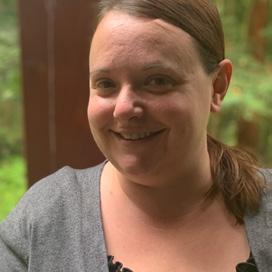

If you can’t afford therapy for everyone, seek help for your child, look into local services as some areas offer support specifically for those who self-harm, and maybe read the book Helping Teens Who Cut by Michael Hollander.
And finally, love your child even more. Show them you do. Be present. And don’t forget to find joy in the little things.
“And parents, never forget the importance of looking after yourself!” Carrie says. “Seeing our children in pain is the worst thing, and it can be so easy to be consumed by making sure they’re OK. You are a person too, and doing things that keep you happy and calm is even more important in this situation.”
You’ve got this. I know you do. Because I did, even when I thought I didn’t.
Gabrielle G is a mother and poet who writes about love and mental health. Visit authorgabrielleg.com or follow her on Instagram @author.gabrielle.g
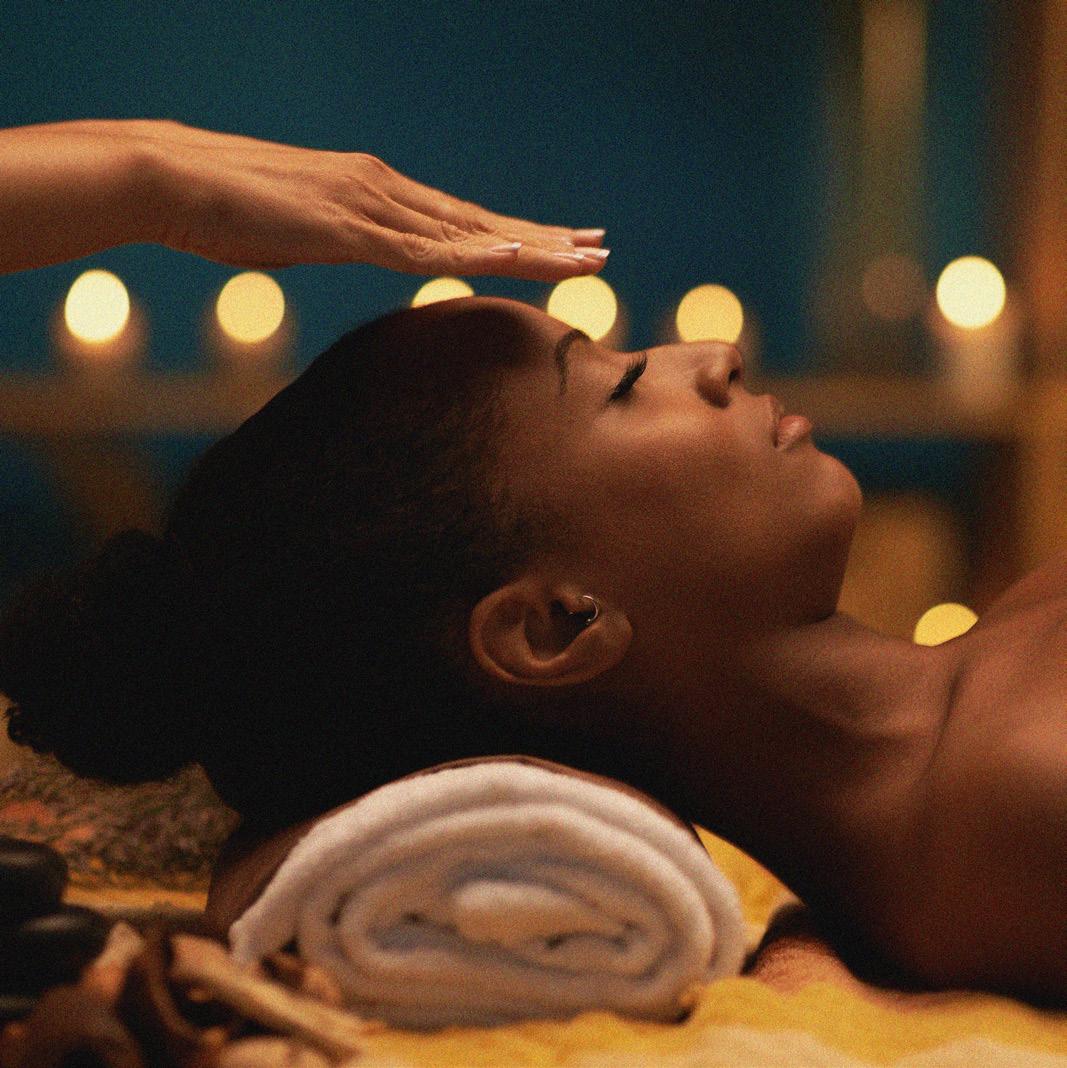
The winter months can be tough. Vitamin D dips, coughs and colds arrive, and SAD are all things to contend with. But complementary therapies can go some way to boosting our wellbeing...
Dive nose-first into aromatherapy, the complementary therapy that uses essential oils from plants and flowers to support your wellbeing. You might opt for an aromatherapy massage, where a unique blend of oils is created for your specific needs. Or you could use oils in a diffuser, or in a bath. Just make sure that, if you’re trying this at home, you check the oils you’re using are body safe.
If you’re looking for relaxation, but the required nearnakedness of other options gives you the shivers, it may be a sign to consider reiki. During a session, you remain fully clothed, sometimes lying under a blanket, and your practitioner will hover their hands over your body. Reiki works on the belief that we have universal life energy, which can become blocked, and during these sessions your practitioner will work to bring you back to balance.
Derived from ancient Chinese medicine, acupuncture uses very fine needles inserted into specific points on the body to treat problems, from aches and pains to overall wellbeing. With a 5,000-year history, acupuncture is still used extensively today, and may be available on the NHS.
Here’s a therapy that’s easy for anyone to tap into. Emotional freedom technique, or ‘tapping’, is a kind of psychological acupressure. A practitioner can teach you how to tap different parts of your body for emotional release, with some believing this can unblock energy channels, similar to acupuncture and reiki.
An adaptation of the yoga you might already be familiar with, yoga therapy caters specifically for those with health problems or injuries. Working with a practitioner to create a personalised treatment plan, take the gentle power of yoga and make it work for you.
Are you a qualified complementary therapist looking to grow your client base? Therapy Directory offers an instant web presence on Google, and, on average, attracts more than 45,000 visitors per month. Create your own unique profile page, and start receiving client enquiries today. Sign up using the code HAPPIFUL to begin your free two-month trial!*
Lost in translation, mixed messages, crossed wires – how many metaphors for ‘miscommunication’ does one language need? A lot, apparently, as it seems that not ‘being on the same page’ as the people around us is far from a unique experience. Add in tricky emotions, uncomfortable truths, and matters we’d prefer to sidestep, and communicating how you really feel becomes quite a daunting mission. Even so, getting it right is of the utmost importance. In fact, a study published by BMC Public Health in 2020 found that poor family support and communication can significantly increase the probability of emotional and behavioural problems in adolescents, and one American study by the American Academy of Matrimonial Lawyers found that 67.5% of marriages that
came to an end had some kind of communication problem. With such high stakes, you’d think that we’d make mastering this skill our top priority – but, as is so often the case with these things, that’s a lot easier said than done.
“If the thought of sharing your feelings makes you want to run for the hills, then I can assure you you’re not alone,” counsellor Melanie Kirk says. “I work with many clients and couples where an inability to do this becomes a real block to effective, healthy communication.”
But why is it that we often find emotional exposure and vulnerability such a challenge? Melanie suggests three main reasons:
1. We fear the reaction we will get. Perhaps we have experienced someone
responding negatively to us in the past when we have tried to be open about how we feel. Maybe it led to conflict, ridicule, misunderstanding, or disappointment.
2. We are not always clear, in our own mind, how we feel and what we need. Sometimes it can be a challenge to translate our thoughts and feelings into something tangible that can be communicated to someone else. It can be difficult to recognise, or name, what we are experiencing.
3. We may anticipate that our needs won’t be met or that we won’t be understood. Again, this could be based on experience, an internalised sense that we can’t be helped, or a belief that nothing would change. >>>
Learn how to improve your emotional communication, and watch your relationships flourish
1. Set aside time to regularly review and check-in. Ask, how do I feel, what do I need, what’s going well, and what am I finding a challenge?
2. Don’t allow things to build up. Getting into the habit of regularly discussing your feelings can make it easier to find a solution. Dealing with emotion when it is a ‘two’ or a ‘three’ is more manageable than when it builds up to an ‘eight’ or a ‘nine’.
3. Notice things that trigger you. Look for patterns and themes to give clues as to what may be generating or maintaining a particular emotion for you. It’s likely that your values or boundaries are being crossed in some way.
Family relationships can be hard to navigate, and often bring out a lot of difficult emotions. But they’re not the only confrontations that we may need to face. Work colleagues, friends, or service providers – there are many scenarios where we need to open up about our emotions. Melanie’s first tip for doing so successfully? Reframe it.
“Vulnerability and connection are intrinsically linked. We often don’t realise that we prevent ourselves from getting what we want because we avoid taking the emotional risk,” she explains. “We need to recognise the ways in which we maintain the unhelpful cycles that play out around us. Once we take
responsibility for our part, we realise that the power to make a change is within our hands.
“There is no doubt that a hard conversation may feel daunting, but reframing the connotations around this can help us to feel more relaxed and better prepared. Sharing the reality of what you think and feel can open a door to understanding, connectedness, and closeness. It’s OK if someone doesn’t agree with you, or view your experiences in the same way, it doesn’t make it any less true. The aim should never be to convince someone to view an experience through your lens, or for you to ‘win’ or ‘be right’. There is very often more than one truth.”

We have so much to gain from sharing our feelings, in fact, a brain imaging study by UCLA found that verbalising our feelings makes our sadness, anger, and pain less intense. So, you’re ready to take control of the situation, to address the elephant in the room, to come clean, just to have an honest chat? Melanie suggests that there are some things you should consider:
1. The timing and environment. Ensure you have privacy and that you don’t have to rush off anywhere.
2. The listener’s circumstances. Try asking if this is a good time to talk, or if an alternative time would be better. Don’t select times when you or the listener might be tired , stressed, or distracted.
3. Take time to formulate your thoughts before you try to communicate them. Be clear
Melanie says: Our brains are really good at trying to fill in the blanks when something doesn’t make sense to us, but often we distort reality. If you want to encourage someone to talk to you, try the following:
1. Say what you notice. ‘I noticed you were quiet when you came home from work.’
2. Stay curious. ‘I was wondering how you feel your shift went?’
3. Ask open questions. ‘What would be helpful right now, what do you need?’
4. Don’t interrupt. Jumping in could stop you from hearing something important.
5. Try paraphrasing. Repeating back your understanding of what they are telling you can be a helpful way to ensure you are both on the same page.
about the intention or goal of the conversation before you begin speaking. Try following a pattern of ‘this is the problem’, ‘this is how I feel about it’, and ‘this is what I need’.
4. Writing things down and using notes can be a helpful way to ensure that you don’t forget anything, especially if you feel nervous.
5. Be conscious of your language. Avoid using words that naturally illicit defence. Start from a position of ‘I need’ or ‘I feel’. It lends itself to a more empathic response.
6. Don’t generalise, avoid using language like ‘you always’ or ‘you never’. Try using ‘when X happened it made me feel Y’.
When it comes to communication, we’re taught our ABCs at school, but the skills needed for emotional honesty, openness, and intimacy, can take a lifetime of work to get a handle on. But, when all’s said and done, most people just want to be heard and understood – and the skills you take forward with you today have the potential to travel from one person to the next, and into the world beyond. So, what do you say?
Melanie Kirk is a relationship therapist. Find more on the Counselling Directory.


We are products of our past, but we don’t have to be prisoners of it
All her life, Motsi Mabuse has worked hard for her countless achievements, but a highly critical and competitive industry led her to question her self-worth. Now, she’s taking back control, consciously practising self-love, radical acceptance of her vulnerability, and making time for those who light up her life
Writing | Lucy Donoughue
By the time you read this Strictly Come Dancing, the muchloved TV sensation, will be back on our screens, and Motsi Mabuse will be sharing guidance and praise for this year’s intake from her place on the judges’ panel. To the show’s army of loyal fans, Motsi is wellknown for exuding warmth, tempered honesty, and the kind of passion that comes from first-hand experience of dancing competitively.


When we speak in late summer, Motsi is sitting under the shade of a poolside umbrella, chatting
animatedly over Facetime about her book, Finding My Own Rhythm, while her daughter plays off-camera. Motsi is taking a break before her busy schedule starts again. She’s allowed herself a couple of hours each day for interviews but, after that, it’s strictly holiday time with her family. Setting healthy boundaries such as this, she says, hasn’t always been possible, and giving herself permission to take a greater level of control over her own time has not only been a revelation, but a conscious practice.
“When I turned 40, my view changed because I had my child and my husband who I very much love,” she says, smiling. “Working hard is one thing, but living is another. I think the problem is that you cannot reach or attain so much if you don’t work hard, but at the same time, that means you have to make sacrifices. However, I’m at a stage in my life now, where I really want to spend a lot of time with the people I love. So I’m very specific about my time, and I’ve built a team around me who have children and family, so they understand me.” >>>
The joy of becoming a mum, combined with the arrival of Covid and a global lockdown, gave Motsi a much-needed period of time to stop, reassess her life, and understand where she needed to make positive changes. In addition to a greater focus on her family, she realised that her relationship with herself needed some nurturing too, after she’d spent most of her life pushing herself to do more, be more, and work harder in the dance industry.
Motsi’s lifelong relationship with the world of dance began when she was just a child. She grew up in South Africa under the system of racial segregation known as apartheid, which, she notes, had a huge impact
on how she saw herself. As she shares in her book: “Growing up within a system that sets certain people above others was bound to have consequences: for the girl I was, for the dancer I became, and for the course I followed. And, although I didn’t fully understand it at the time, perhaps the biggest of these consequences was feeling that I really had to prove my worth. I had to find a way to accept myself and feel accepted; even more than that – to

I’m at a stage in my life now, where I really want to spend a lot of time with these people I lovePhotography | Andrew Hayes-Watkins
be celebrated for who I was and the talents I had, as every person should be.”
Revisiting her early years was tough for Motsi, especially when it came to reading back her words for the audio book. “That made me cry a few times,” she says. “I’m a grown woman now and, as an adult, looking at that child, I had so much empathy, sympathy, and love. I wanted to give love to that little girl. It was quite an awakening, hearing those words out loud and also being able to hear them from a place where I’m able to think that this is a part of me, that is behind me.”
In sharing her story to date, Motsi also detailed the lengths she had to go to in order to become a professional competitive dancer. She endured harsh criticism, scrutiny, and the economic disadvantages that breaking into the industry can bring. The continual discourse around her body also affected her deeply, and impacted the way she saw herself.
With these years in the rearview mirror, it would be all too easy to suggest that Motsi has triumphed in the face of undeserved criticism. But as with us all, her early experiences have left their mark and this, she shares, takes work to undo.
“Working on these things when you’re in the public eye isn’t always the easiest. You go through ups and downs and learnings,” she explains. “For example, when I was a dancer I didn’t have money. Then, when I started
working more, I got money and all these fancy and expensive things, and then I realised they didn’t help. It can be so tempting to buy or do the next thing that will fill a gap, or that people will validate you for, until you realise the validation comes from within.
“And working on learning to validate yourself is so, so difficult,” she continues. “We all speak about self-love, selfacceptance, self-awareness to the point these words are just hashtags on social media, but we have to apply these concepts to ourselves.”
This can be easier said than done, Motsi notes, but she’s willing to be transparent about how she actively tries. “Sometimes, I’m so vulnerable. I tell my husband and I hate that he will see me in that way. But
I’ve made the step of telling someone and then I go through it. I feel it and I move on. Maybe the next day I go three steps back, but I keep on going.”
Motsi certainly keeps moving forward. In her career, in her efforts to create a greater worklife balance, and in her selfworth practice. It sounds like the hard work, once again, is paying off for her.
“I’ve decided to accept that’s who I am. I’m vulnerable, I’m very emotional. I’m a sensitive
person and I’m always going to be that way,” she concludes. “I would never tell someone that I’m the most confident person, or the person that feels the most self-worth. I think I’m just now really learning to say, ‘I’m proud of me.’”
‘Finding My Own Rhythm’ by Motsi Mabuse (Ebury Spotlight, £20) is out now. Watch ‘Strictly Come Dancing’ on BBC One and BBC iPlayer.

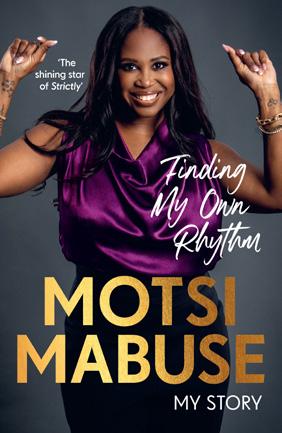
I would never tell someone that I’m the most confident person, or the person that feels that most self-worth
In these uncertain times, it can be quite a challenge to think about feeding your family; cooking a healthy dish that everyone will like and is easy on the purse strings. With increasing food costs and utility bills, a one-pot or traybake can be a great go-to. When the days become shorter and the temperature drops, what’s better than warm, comforting food? Lasagne is a traditional recipe, and a firm favourite for all of the family – in this recipe, I’ve made some swaps to ensure it’s both flavourful and filling, while using ingredients that are not only affordable, but readily available in most supermarkets.
Ingredients (Serves 6)
• Olive oil
• 4 carrots, peeled and finely diced
• 2 onions, finely diced
• 2 celery stalks, finely diced
• 2 garlic cloves, crushed or finely chopped
• 500g lean turkey mince
• 2 tbsp tomato purée
• 400g tin chopped tomatoes
• 1 tsp oregano or dried herbs
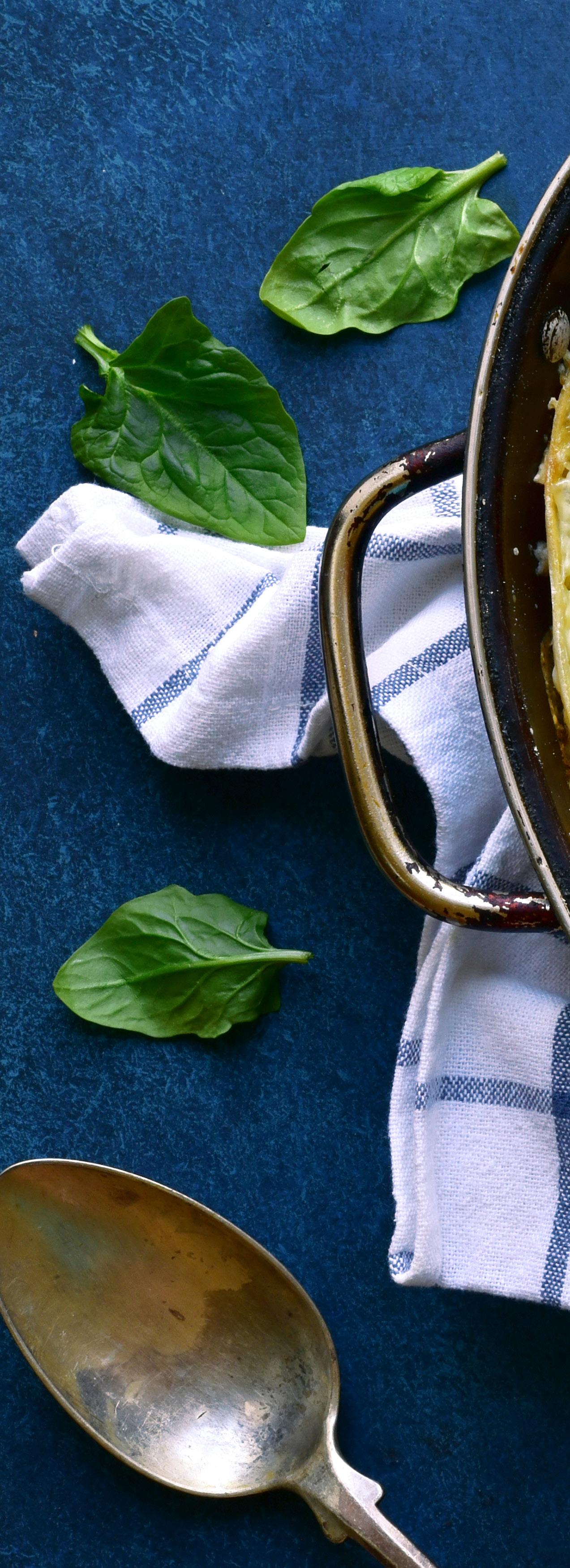
• 8-10 wholewheat lasagne sheets
• 50g Parmesan cheese
For the topping:
• 500g natural yoghurt
• 2 eggs, lightly beaten
• A pinch of nutmeg
• A handful of spinach, chopped
• Heat 1 tbsp oil in a large pan, and gently fry the carrot, onion, celery and garlic for 15 minutes until softened.
• Add the turkey mince. Fry for 5–10 minutes until the mince is browned.
• Add the tomato purée and stir into the mince. Add the tomatoes, herbs, and half a tin of water. Simmer for 30 minutes, allowing the sauce to thicken.
• Heat the oven to 180oC/fan 160oC/gas 4.
• Mix the yoghurt, eggs, and nutmeg. Add the chopped spinach.

• Put a ladle or two of the tomato sauce in a large baking dish, and cover with a few lasagne sheets. Keep layering up until the sauce has been used, finishing with a layer of pasta.
• Pour over the yoghurt mixture and scatter with the parmesan.
• Bake for about 40–45 mins, or until the sauce is bubbling and the top is golden. Check halfway through, and cover with foil if it’s getting too dark.
• Serve with a salad, or your vegetables of choice.
I’ve substituted the traditional beef mince for turkey mince in this recipe, as turkey is very lean, high in protein, and typically cheaper than beef. Turkey is an excellent source of vitamin B3, which helps to release energy from the food we eat, supports normal nervous system function, fights fatigue, and helps to keep our skin healthy. It also contains the amino acid, tryptophan, which helps make serotonin, a neurotransmitter which regulates our mood, and melatonin, a hormone that promotes sleep.
Swapping white pasta for wholewheat lasagne sheets provides more fibre, which helps to stabilise your blood sugar levels and keeps you feeling fuller for longer. And opting for a yoghurt topping instead of the traditional white sauce helps reduce the saturated fat.
The best thing about this dish is that you can add whatever vegetables you want. Try adding chopped mushrooms, grated sweet potato or courgette, butternut squash, peppers or aubergines in step one.
Eating a variety of vegetables not only introduces more nutrients, but increases the diversity of gut bacteria. Gut bacteria play an important role in helping control our digestion, influencing our immune system and even our mood.
Filomena Komodromou is a nutritional therapist. Find more on her profile at the Nutritionist Resource.
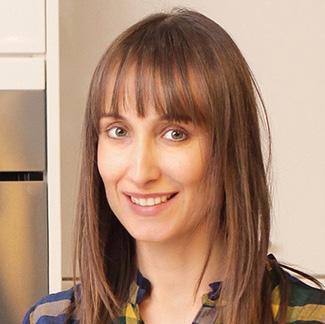
Who wouldn’t love to be more carefree?
To go back to a simpler time, when everyday responsibilities didn’t rule your day-to-day life, and you could live more in the moment.
Yet many of us know that, despite our love of nostalgia and occasional indulgences in activities we enjoyed in our younger years, we still have to face up to the emotional and financial challenges of adulthood. But… what if you didn’t? What if you just refused to take responsibility at work, in relationships, and in life?
The term was coined in 1983 by Dr Dan Kiley in his book, Peter Pan Syndrome: Men Who Have Never Grown Up. While it’s not an officially recognised psychological disorder, Peter Pan syndrome refers to a type of behaviour that can affect anyone, of any gender or culture.
Someone exhibiting signs of Peter Pan syndrome may appear anxious when being evaluated by colleagues or managers, being unable to tolerate any form
of criticism. They may have serious problems adapting at work, or in romantic or platonic relationships. Common signs within a relationship can include:
• Being unable to keep promises, stick to commitments, or take on responsibilities.
• Constantly changing partners (typically for someone younger) to avoid commitment.
• Refusal, reluctance, or inability to define relationships.
• Neglecting general life admin (basic household tasks), or relying on others to do things for them.
• Avoiding acknowledging, addressing, or fixing relationship issues.
• An unwillingness to make big decisions or plan ahead.
But Peter Pan syndrome can affect more than just personal relationships. For many at work, it can also include:
• Difficulty adapting or receiving criticism.
• Constantly being late, skipping work, putting in little effort, or making excuses for poor performance.
• Job hopping due to boredom, difficulty, stress, or lack of skills (and unwillingness to work towards improvement).
• A preference for lowcommitment, part-time roles.
• Focusing on dreams without putting in time, effort, or realistic goals to meet them (e.g. going from couch potato to competitive athlete).
Other common behaviours can include difficulty with finances or unwise spending, an excessive interest in their looks or wellbeing, a general air of helplessness, a lack of accountability, fear of criticism, and expectation that others will do things for them. While these may all seem like clear warning signs from the outside, often, for those experiencing Peter Pan syndrome, they do not view their behaviour as problematic.
do people develop Peter Pan syndrome?
Views on this are a little divided. One avenue of thought is that, for some people, overly protective families may have unintentionally led to us failing to develop the skills needed to get by in life. This,
We’ve all heard the story of the boy who never grew up. But do you know someone like that in real life?
in turn, results in us being ‘stuck’ in a state of adolescence, where we may feel unable or unwilling to step up and take on more responsibilities.
Other researchers believe that parenting styles which are too laid back can lead to the same lack of skill development, as well as causing us to focus on the purely fun aspects of life. Too many boundaries, or not enough, can lead to us failing to learn about consequences, individual responsibilities, and how to cope (and thrive) under normal, everyday pressures.
Are there long-term effects?
For those experiencing it, Peter Pan syndrome can have its ups and downs. The individual may have a more playful outlook, which can reduce stress levels. Their focus on spontaneity and enjoying the little things can also have a positive impact on some loved ones and friends, helping them to relax or take a breather. However, it can also cause additional stress and worry, imbalanced relationships and responsibilities, and even the development of resentment.

They may struggle to maintain long-term relationships, lag behind or struggle to start a career, and even encounter financial difficulties due to trouble planning, and impulsive spending habits.
While you can encourage a loved one to make positive changes and seek help, it’s important that the person recognises that they have a problem, and are willing to change. Without being both ready and willing to address unhelpful behaviours, pushing a friend or family member to seek help can be frustrating all-round. And the
same goes for recognising these symptoms in your own behaviour – be honest with yourself, and consider whether you need help to address it.
Clear communication is key. This is vital to maintaining healthy relationships. If one or both of you don’t feel heard, it can lead to feelings of resentment and frustration.
Working with a therapist can help you to improve communication skills and discuss issues that may be bothering you, in a safe, neutral, judgement-free environment. To find out more about working with a counsellor, visit the Counselling Directory.
Whether you love or loathe gift wrapping, there are a few things we can do to make it more a mindful. Dim the lights, play some holiday music, pour a glass of your favourite festive tipple. As you wrap, take a moment to feel the texture of the paper, notice the colours of the bows, and the delicious sound your scissors make when cutting. Go slow and lose yourself in the process.
Going for a winter walk
Heading outside when it’s cold may not seem appealing, but there’s magic to be found on winter walks. Wrap up in your favourite coat, scarf, hat, and gloves. Pull on some boots with good grip to navigate any icy patches, and make your way outside.
Notice the way the bracing air feels as it hits your skin. Look out for interesting patterns, perhaps there are footprints in snow or some particularly pleasing brickwork. Listen out for birds singing, squirrels scurrying, and trees swaying in the wind. If you’re in a
city, can you hear snippets of conversations on the breeze?
Having a mindful moment is all about doing something slowly and with intention. With this in mind, making a hot chocolate can become a ritual. Use your favourite mug (the bigger the better in our opinion) and use your senses to explore every step of creation, from warming the milk and adding the chocolate, to finishing with a flurry of marshmallows.
If possible, take some time to sip it slowly, noticing the flavour with each mouthful. While drinking, cosy up with a good book, listen to a calming playlist, or simply look out the
window and take a moment to be fully present.
Aromatherapy is a simple yet effective way to make any moment more mindful, as it triggers our sense of smell and pulls us into the here and now. Look for warming and fresh scents such as nutmeg, pine, frankincense, cinnamon, orange, or clove.
Use your candle as a way to signal relaxation time, perhaps after you finish work for the day, or when the kids are tucked up in bed. Light the candle and pause for a moment to watch the flame (you could even try a candle meditation) and notice the scent, taking slow, deep breaths.

While we always hope the holidays will be relaxed and joyful, stress can show up as we navigate family dynamics, financial strains, and societal pressure. Here we share some ideas to help you find mindful moments so you can return to calm






